Mining Giants: BHP vs Rio Tinto
VerifiedAdded on 2020/06/05
|33
|10149
|34
AI Summary
This assignment presents a comparative analysis of two leading mining companies: BHP Billiton and Rio Tinto. It delves into their market shares across various commodities, examines their financial performance by analyzing key ratios like return on assets (ROA), and explores their operational strengths and areas of focus.
Contribute Materials
Your contribution can guide someone’s learning journey. Share your
documents today.
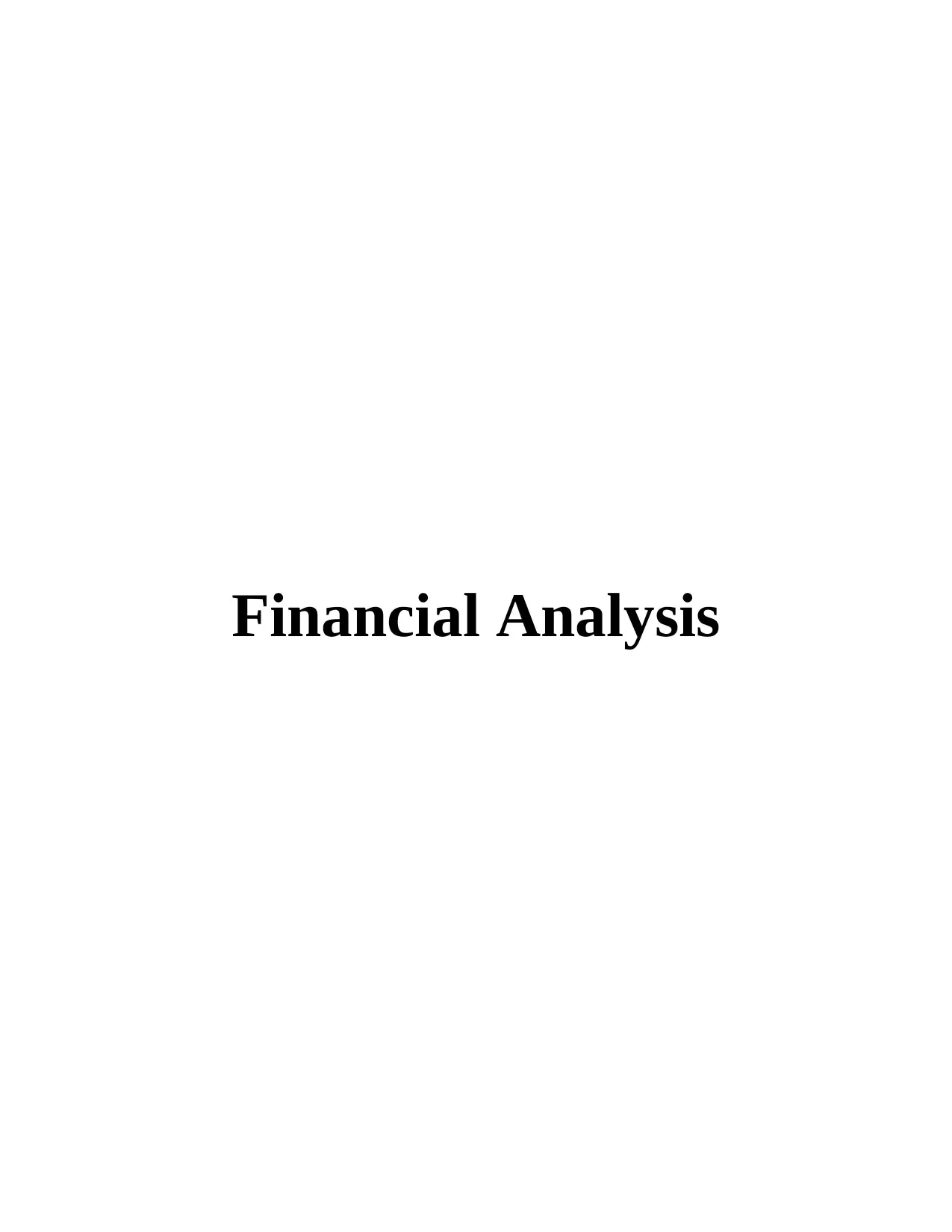
Financial Analysis
Secure Best Marks with AI Grader
Need help grading? Try our AI Grader for instant feedback on your assignments.
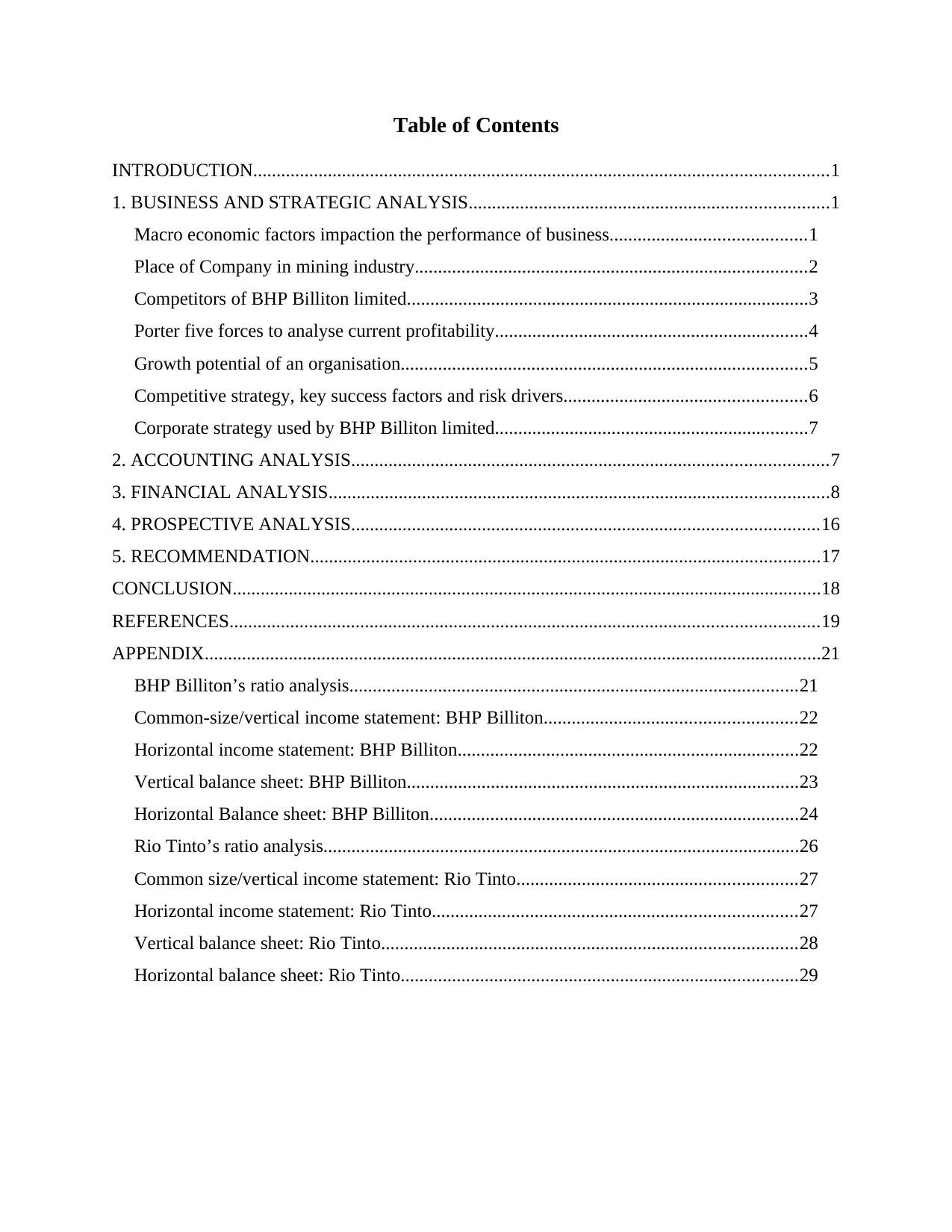
Table of Contents
INTRODUCTION...........................................................................................................................1
1. BUSINESS AND STRATEGIC ANALYSIS.............................................................................1
Macro economic factors impaction the performance of business..........................................1
Place of Company in mining industry....................................................................................2
Competitors of BHP Billiton limited......................................................................................3
Porter five forces to analyse current profitability...................................................................4
Growth potential of an organisation.......................................................................................5
Competitive strategy, key success factors and risk drivers....................................................6
Corporate strategy used by BHP Billiton limited...................................................................7
2. ACCOUNTING ANALYSIS......................................................................................................7
3. FINANCIAL ANALYSIS...........................................................................................................8
4. PROSPECTIVE ANALYSIS....................................................................................................16
5. RECOMMENDATION.............................................................................................................17
CONCLUSION..............................................................................................................................18
REFERENCES..............................................................................................................................19
APPENDIX....................................................................................................................................21
BHP Billiton’s ratio analysis................................................................................................21
Common-size/vertical income statement: BHP Billiton......................................................22
Horizontal income statement: BHP Billiton.........................................................................22
Vertical balance sheet: BHP Billiton....................................................................................23
Horizontal Balance sheet: BHP Billiton...............................................................................24
Rio Tinto’s ratio analysis......................................................................................................26
Common size/vertical income statement: Rio Tinto............................................................27
Horizontal income statement: Rio Tinto..............................................................................27
Vertical balance sheet: Rio Tinto.........................................................................................28
Horizontal balance sheet: Rio Tinto.....................................................................................29
INTRODUCTION...........................................................................................................................1
1. BUSINESS AND STRATEGIC ANALYSIS.............................................................................1
Macro economic factors impaction the performance of business..........................................1
Place of Company in mining industry....................................................................................2
Competitors of BHP Billiton limited......................................................................................3
Porter five forces to analyse current profitability...................................................................4
Growth potential of an organisation.......................................................................................5
Competitive strategy, key success factors and risk drivers....................................................6
Corporate strategy used by BHP Billiton limited...................................................................7
2. ACCOUNTING ANALYSIS......................................................................................................7
3. FINANCIAL ANALYSIS...........................................................................................................8
4. PROSPECTIVE ANALYSIS....................................................................................................16
5. RECOMMENDATION.............................................................................................................17
CONCLUSION..............................................................................................................................18
REFERENCES..............................................................................................................................19
APPENDIX....................................................................................................................................21
BHP Billiton’s ratio analysis................................................................................................21
Common-size/vertical income statement: BHP Billiton......................................................22
Horizontal income statement: BHP Billiton.........................................................................22
Vertical balance sheet: BHP Billiton....................................................................................23
Horizontal Balance sheet: BHP Billiton...............................................................................24
Rio Tinto’s ratio analysis......................................................................................................26
Common size/vertical income statement: Rio Tinto............................................................27
Horizontal income statement: Rio Tinto..............................................................................27
Vertical balance sheet: Rio Tinto.........................................................................................28
Horizontal balance sheet: Rio Tinto.....................................................................................29

INTRODUCTION
Financial analysis is of great importance for the firm as it helps in making strategies
according to growth and development of business. Analysing financials of the BHP Billiton
assists the management in establishing reliability, viability, stability and profitability of business.
BHP Billiton is the second largest chain in mining industry. The report will outline the various
business strategies used by the business to analysis its strength and strategies which assist the
enterprise in dealing with fluctuations. Moreover, it will evaluate competition and corporate
strategies used by BHP to attain competitive advantage. Further, the report will outline annual
report data of BHP and its competitors which helps the company to make stability in the mining
industry.
1. BUSINESS AND STRATEGIC ANALYSIS
Macro economic factors impaction the performance of business.
In order to analyse competitive performance the company first focus on analysing in
macro economic factors with the use of PEST analysis which is as follows: Political: BHP Billiton is a leading mining organisation which is adapts changes as per
the political risk and fluctuations. Whereas there are few factors which are impacting the
growth and development of business in the industry. The major impact is caused by
changing government policies, rent agreements, terrorism, liberal leaders and many more.
For instance, the mandatory compliance of Mineral and petroleum resources development
act 2002 led to a major financial loss to firm. Economical: The fluctuation in expense, material, cost, labour can impact the growth and
development plans of enterprise. BHP Billiton is juggling to maintain stability with
changing economic factors but the loopholes in global economic factors are affecting net
turnover and demand and supply of products and services. Socio cultural: The company follows all the possible policies and procedures which can
affect the socio culture (Mauree and Geneletti 2017). Theses factors are depended on the
support provided by enterprise to neighbouring communities therefore BHP Billiton has
taken steps to maintaining appropriate working conditions, quality of life to most
neighbouring cities. For instance, currently the company is focusing on supporting its
neighbour Antofagasta.
1
Financial analysis is of great importance for the firm as it helps in making strategies
according to growth and development of business. Analysing financials of the BHP Billiton
assists the management in establishing reliability, viability, stability and profitability of business.
BHP Billiton is the second largest chain in mining industry. The report will outline the various
business strategies used by the business to analysis its strength and strategies which assist the
enterprise in dealing with fluctuations. Moreover, it will evaluate competition and corporate
strategies used by BHP to attain competitive advantage. Further, the report will outline annual
report data of BHP and its competitors which helps the company to make stability in the mining
industry.
1. BUSINESS AND STRATEGIC ANALYSIS
Macro economic factors impaction the performance of business.
In order to analyse competitive performance the company first focus on analysing in
macro economic factors with the use of PEST analysis which is as follows: Political: BHP Billiton is a leading mining organisation which is adapts changes as per
the political risk and fluctuations. Whereas there are few factors which are impacting the
growth and development of business in the industry. The major impact is caused by
changing government policies, rent agreements, terrorism, liberal leaders and many more.
For instance, the mandatory compliance of Mineral and petroleum resources development
act 2002 led to a major financial loss to firm. Economical: The fluctuation in expense, material, cost, labour can impact the growth and
development plans of enterprise. BHP Billiton is juggling to maintain stability with
changing economic factors but the loopholes in global economic factors are affecting net
turnover and demand and supply of products and services. Socio cultural: The company follows all the possible policies and procedures which can
affect the socio culture (Mauree and Geneletti 2017). Theses factors are depended on the
support provided by enterprise to neighbouring communities therefore BHP Billiton has
taken steps to maintaining appropriate working conditions, quality of life to most
neighbouring cities. For instance, currently the company is focusing on supporting its
neighbour Antofagasta.
1

Technological: The growth of mining industry is completely depended on advancement
of technology therefore the enterprise is focusing on exploring and adapting changes
which can help the business in serving customer satisfaction and maintain its profitability
(Pike, Spennemann and Watson 2017). Moreover, the management of firm believes that
investment in appropriate technological resources can assist BHP Billiton in adapting
fluctuations quickly. For instance, the major technological up-gradation in mining
industry are, machinery, refiners, cranes and lorry. The advanced technology used by
BHP Billiton are Advanced shaft and tunnel boring stems, 3D laser scanning and
automated drilling.\
Industry Analysis
Place of Company in mining industry.
Market position: BHP Billiton is striving hard to maintain is leading position in the
mining industry but still it holds the second position after Rio Tinto Besides the prices of iron ore
is falling but still the company is focusing on increasing its production level to meet the demand
of the consumers. The business operations are, extracting resources, and manufacturing products.
Market Share: There are 4 competitors which are, Rio Tinto, Arconic Inc. and Vale S/A
form which BHP Billiton is competing for the high market share according to its commodities
like for copper its holds 7%, for seaborne thermal coal it holds 5% and for seaborne coking coal
it holds 19% that is highest amongst all the rivalries of mining industry (James K. and et.al.,
2014). Thus, the management is focusing on grabbing the market share for all of its metal and
materials therefore the enterprise is slowly drifting towards oligopoly like potash market. Beside,
the data represents that the mining industry is under the control of BHP. The data demonstrate
that, the maximum market share is for its iron ore production which is 29% and least is for
diamonds which is 2 percent. Despite of highest and lowest the company holds the strong control
over its base metals, energy coals and petroleum
2
of technology therefore the enterprise is focusing on exploring and adapting changes
which can help the business in serving customer satisfaction and maintain its profitability
(Pike, Spennemann and Watson 2017). Moreover, the management of firm believes that
investment in appropriate technological resources can assist BHP Billiton in adapting
fluctuations quickly. For instance, the major technological up-gradation in mining
industry are, machinery, refiners, cranes and lorry. The advanced technology used by
BHP Billiton are Advanced shaft and tunnel boring stems, 3D laser scanning and
automated drilling.\
Industry Analysis
Place of Company in mining industry.
Market position: BHP Billiton is striving hard to maintain is leading position in the
mining industry but still it holds the second position after Rio Tinto Besides the prices of iron ore
is falling but still the company is focusing on increasing its production level to meet the demand
of the consumers. The business operations are, extracting resources, and manufacturing products.
Market Share: There are 4 competitors which are, Rio Tinto, Arconic Inc. and Vale S/A
form which BHP Billiton is competing for the high market share according to its commodities
like for copper its holds 7%, for seaborne thermal coal it holds 5% and for seaborne coking coal
it holds 19% that is highest amongst all the rivalries of mining industry (James K. and et.al.,
2014). Thus, the management is focusing on grabbing the market share for all of its metal and
materials therefore the enterprise is slowly drifting towards oligopoly like potash market. Beside,
the data represents that the mining industry is under the control of BHP. The data demonstrate
that, the maximum market share is for its iron ore production which is 29% and least is for
diamonds which is 2 percent. Despite of highest and lowest the company holds the strong control
over its base metals, energy coals and petroleum
2
Secure Best Marks with AI Grader
Need help grading? Try our AI Grader for instant feedback on your assignments.
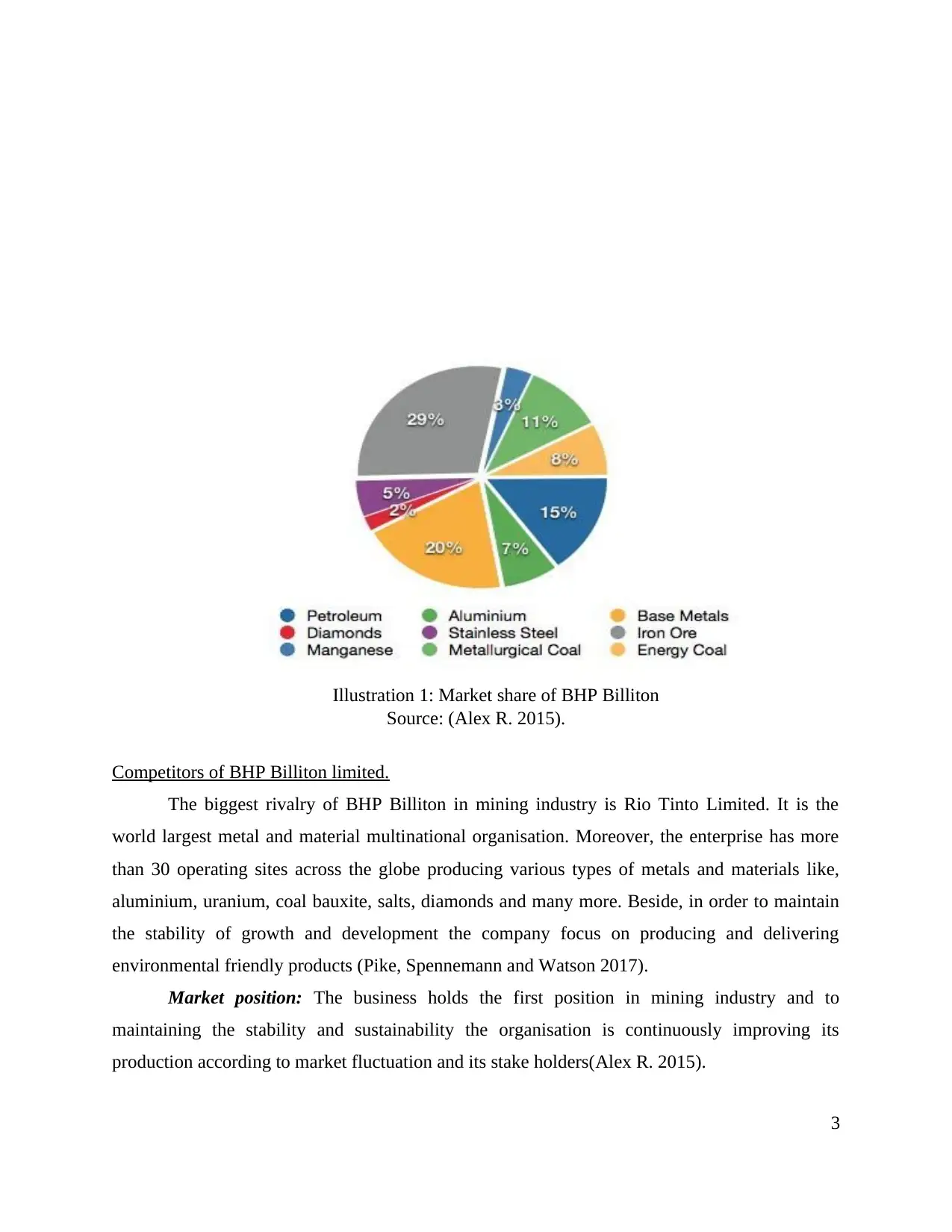
Source: (Alex R. 2015).
Competitors of BHP Billiton limited.
The biggest rivalry of BHP Billiton in mining industry is Rio Tinto Limited. It is the
world largest metal and material multinational organisation. Moreover, the enterprise has more
than 30 operating sites across the globe producing various types of metals and materials like,
aluminium, uranium, coal bauxite, salts, diamonds and many more. Beside, in order to maintain
the stability of growth and development the company focus on producing and delivering
environmental friendly products (Pike, Spennemann and Watson 2017).
Market position: The business holds the first position in mining industry and to
maintaining the stability and sustainability the organisation is continuously improving its
production according to market fluctuation and its stake holders(Alex R. 2015).
3
Illustration 1: Market share of BHP Billiton
Competitors of BHP Billiton limited.
The biggest rivalry of BHP Billiton in mining industry is Rio Tinto Limited. It is the
world largest metal and material multinational organisation. Moreover, the enterprise has more
than 30 operating sites across the globe producing various types of metals and materials like,
aluminium, uranium, coal bauxite, salts, diamonds and many more. Beside, in order to maintain
the stability of growth and development the company focus on producing and delivering
environmental friendly products (Pike, Spennemann and Watson 2017).
Market position: The business holds the first position in mining industry and to
maintaining the stability and sustainability the organisation is continuously improving its
production according to market fluctuation and its stake holders(Alex R. 2015).
3
Illustration 1: Market share of BHP Billiton
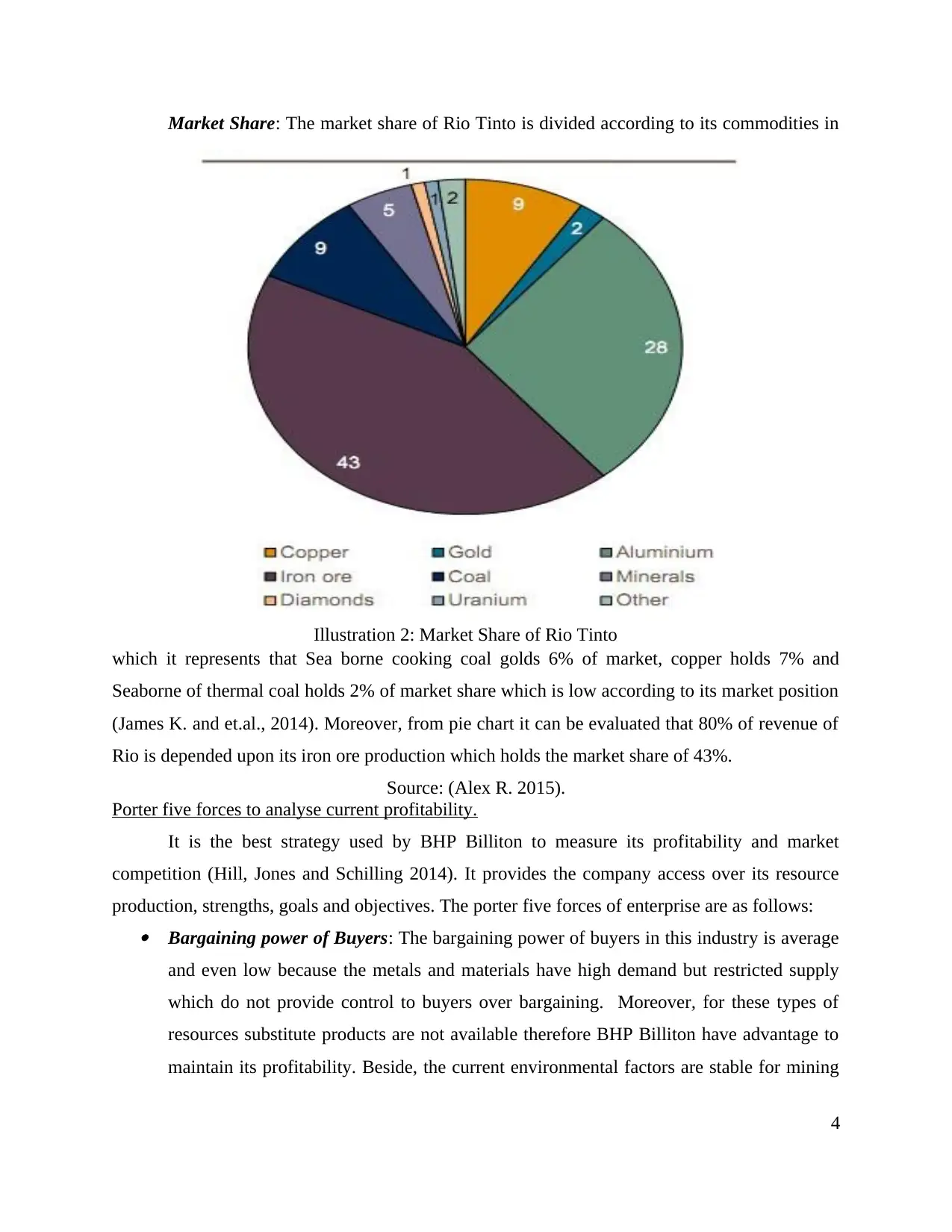
Market Share: The market share of Rio Tinto is divided according to its commodities in
which it represents that Sea borne cooking coal golds 6% of market, copper holds 7% and
Seaborne of thermal coal holds 2% of market share which is low according to its market position
(James K. and et.al., 2014). Moreover, from pie chart it can be evaluated that 80% of revenue of
Rio is depended upon its iron ore production which holds the market share of 43%.
Source: (Alex R. 2015).
Porter five forces to analyse current profitability.
It is the best strategy used by BHP Billiton to measure its profitability and market
competition (Hill, Jones and Schilling 2014). It provides the company access over its resource
production, strengths, goals and objectives. The porter five forces of enterprise are as follows: Bargaining power of Buyers: The bargaining power of buyers in this industry is average
and even low because the metals and materials have high demand but restricted supply
which do not provide control to buyers over bargaining. Moreover, for these types of
resources substitute products are not available therefore BHP Billiton have advantage to
maintain its profitability. Beside, the current environmental factors are stable for mining
4
Illustration 2: Market Share of Rio Tinto
which it represents that Sea borne cooking coal golds 6% of market, copper holds 7% and
Seaborne of thermal coal holds 2% of market share which is low according to its market position
(James K. and et.al., 2014). Moreover, from pie chart it can be evaluated that 80% of revenue of
Rio is depended upon its iron ore production which holds the market share of 43%.
Source: (Alex R. 2015).
Porter five forces to analyse current profitability.
It is the best strategy used by BHP Billiton to measure its profitability and market
competition (Hill, Jones and Schilling 2014). It provides the company access over its resource
production, strengths, goals and objectives. The porter five forces of enterprise are as follows: Bargaining power of Buyers: The bargaining power of buyers in this industry is average
and even low because the metals and materials have high demand but restricted supply
which do not provide control to buyers over bargaining. Moreover, for these types of
resources substitute products are not available therefore BHP Billiton have advantage to
maintain its profitability. Beside, the current environmental factors are stable for mining
4
Illustration 2: Market Share of Rio Tinto
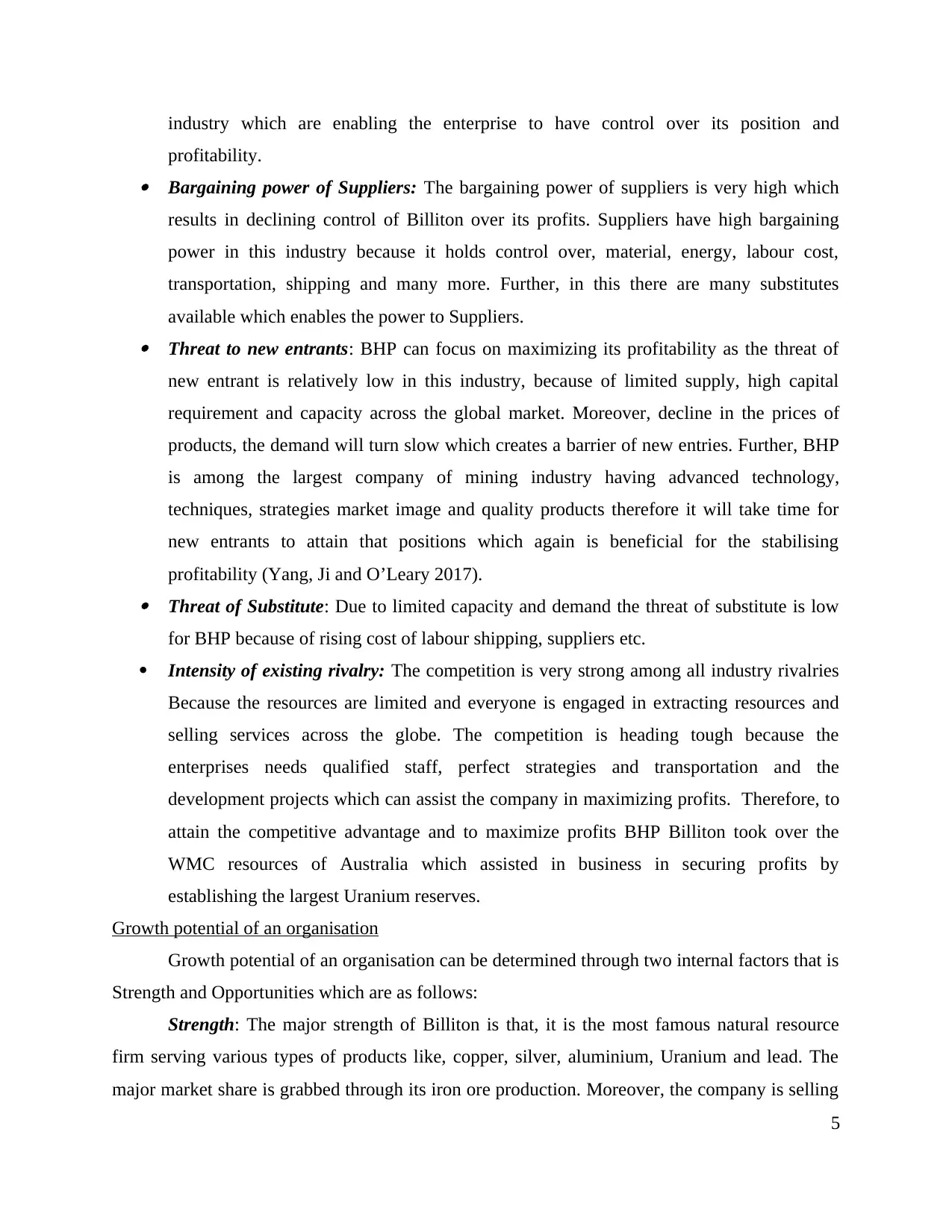
industry which are enabling the enterprise to have control over its position and
profitability. Bargaining power of Suppliers: The bargaining power of suppliers is very high which
results in declining control of Billiton over its profits. Suppliers have high bargaining
power in this industry because it holds control over, material, energy, labour cost,
transportation, shipping and many more. Further, in this there are many substitutes
available which enables the power to Suppliers. Threat to new entrants: BHP can focus on maximizing its profitability as the threat of
new entrant is relatively low in this industry, because of limited supply, high capital
requirement and capacity across the global market. Moreover, decline in the prices of
products, the demand will turn slow which creates a barrier of new entries. Further, BHP
is among the largest company of mining industry having advanced technology,
techniques, strategies market image and quality products therefore it will take time for
new entrants to attain that positions which again is beneficial for the stabilising
profitability (Yang, Ji and O’Leary 2017). Threat of Substitute: Due to limited capacity and demand the threat of substitute is low
for BHP because of rising cost of labour shipping, suppliers etc.
Intensity of existing rivalry: The competition is very strong among all industry rivalries
Because the resources are limited and everyone is engaged in extracting resources and
selling services across the globe. The competition is heading tough because the
enterprises needs qualified staff, perfect strategies and transportation and the
development projects which can assist the company in maximizing profits. Therefore, to
attain the competitive advantage and to maximize profits BHP Billiton took over the
WMC resources of Australia which assisted in business in securing profits by
establishing the largest Uranium reserves.
Growth potential of an organisation
Growth potential of an organisation can be determined through two internal factors that is
Strength and Opportunities which are as follows:
Strength: The major strength of Billiton is that, it is the most famous natural resource
firm serving various types of products like, copper, silver, aluminium, Uranium and lead. The
major market share is grabbed through its iron ore production. Moreover, the company is selling
5
profitability. Bargaining power of Suppliers: The bargaining power of suppliers is very high which
results in declining control of Billiton over its profits. Suppliers have high bargaining
power in this industry because it holds control over, material, energy, labour cost,
transportation, shipping and many more. Further, in this there are many substitutes
available which enables the power to Suppliers. Threat to new entrants: BHP can focus on maximizing its profitability as the threat of
new entrant is relatively low in this industry, because of limited supply, high capital
requirement and capacity across the global market. Moreover, decline in the prices of
products, the demand will turn slow which creates a barrier of new entries. Further, BHP
is among the largest company of mining industry having advanced technology,
techniques, strategies market image and quality products therefore it will take time for
new entrants to attain that positions which again is beneficial for the stabilising
profitability (Yang, Ji and O’Leary 2017). Threat of Substitute: Due to limited capacity and demand the threat of substitute is low
for BHP because of rising cost of labour shipping, suppliers etc.
Intensity of existing rivalry: The competition is very strong among all industry rivalries
Because the resources are limited and everyone is engaged in extracting resources and
selling services across the globe. The competition is heading tough because the
enterprises needs qualified staff, perfect strategies and transportation and the
development projects which can assist the company in maximizing profits. Therefore, to
attain the competitive advantage and to maximize profits BHP Billiton took over the
WMC resources of Australia which assisted in business in securing profits by
establishing the largest Uranium reserves.
Growth potential of an organisation
Growth potential of an organisation can be determined through two internal factors that is
Strength and Opportunities which are as follows:
Strength: The major strength of Billiton is that, it is the most famous natural resource
firm serving various types of products like, copper, silver, aluminium, Uranium and lead. The
major market share is grabbed through its iron ore production. Moreover, the company is selling
5
Paraphrase This Document
Need a fresh take? Get an instant paraphrase of this document with our AI Paraphraser
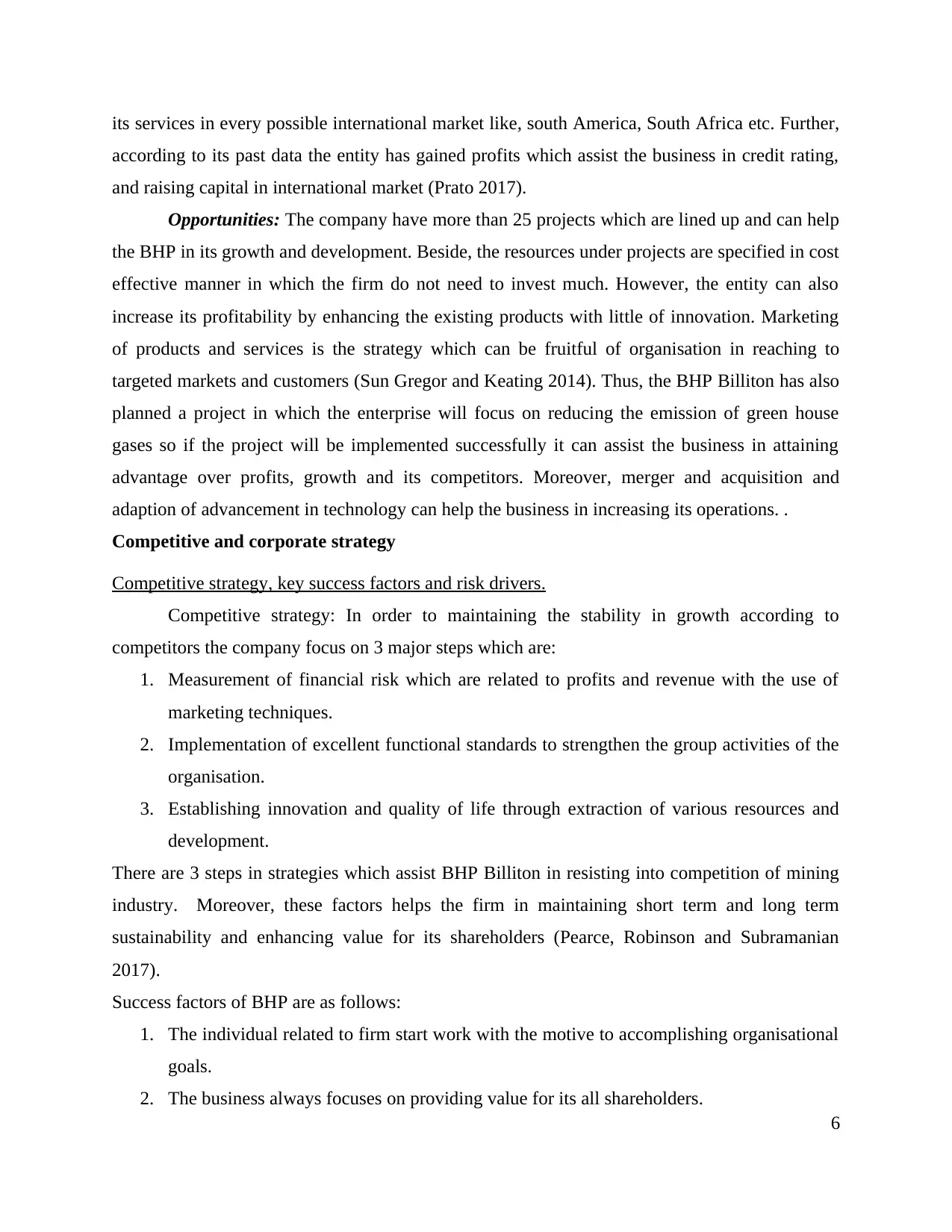
its services in every possible international market like, south America, South Africa etc. Further,
according to its past data the entity has gained profits which assist the business in credit rating,
and raising capital in international market (Prato 2017).
Opportunities: The company have more than 25 projects which are lined up and can help
the BHP in its growth and development. Beside, the resources under projects are specified in cost
effective manner in which the firm do not need to invest much. However, the entity can also
increase its profitability by enhancing the existing products with little of innovation. Marketing
of products and services is the strategy which can be fruitful of organisation in reaching to
targeted markets and customers (Sun Gregor and Keating 2014). Thus, the BHP Billiton has also
planned a project in which the enterprise will focus on reducing the emission of green house
gases so if the project will be implemented successfully it can assist the business in attaining
advantage over profits, growth and its competitors. Moreover, merger and acquisition and
adaption of advancement in technology can help the business in increasing its operations. .
Competitive and corporate strategy
Competitive strategy, key success factors and risk drivers.
Competitive strategy: In order to maintaining the stability in growth according to
competitors the company focus on 3 major steps which are:
1. Measurement of financial risk which are related to profits and revenue with the use of
marketing techniques.
2. Implementation of excellent functional standards to strengthen the group activities of the
organisation.
3. Establishing innovation and quality of life through extraction of various resources and
development.
There are 3 steps in strategies which assist BHP Billiton in resisting into competition of mining
industry. Moreover, these factors helps the firm in maintaining short term and long term
sustainability and enhancing value for its shareholders (Pearce, Robinson and Subramanian
2017).
Success factors of BHP are as follows:
1. The individual related to firm start work with the motive to accomplishing organisational
goals.
2. The business always focuses on providing value for its all shareholders.
6
according to its past data the entity has gained profits which assist the business in credit rating,
and raising capital in international market (Prato 2017).
Opportunities: The company have more than 25 projects which are lined up and can help
the BHP in its growth and development. Beside, the resources under projects are specified in cost
effective manner in which the firm do not need to invest much. However, the entity can also
increase its profitability by enhancing the existing products with little of innovation. Marketing
of products and services is the strategy which can be fruitful of organisation in reaching to
targeted markets and customers (Sun Gregor and Keating 2014). Thus, the BHP Billiton has also
planned a project in which the enterprise will focus on reducing the emission of green house
gases so if the project will be implemented successfully it can assist the business in attaining
advantage over profits, growth and its competitors. Moreover, merger and acquisition and
adaption of advancement in technology can help the business in increasing its operations. .
Competitive and corporate strategy
Competitive strategy, key success factors and risk drivers.
Competitive strategy: In order to maintaining the stability in growth according to
competitors the company focus on 3 major steps which are:
1. Measurement of financial risk which are related to profits and revenue with the use of
marketing techniques.
2. Implementation of excellent functional standards to strengthen the group activities of the
organisation.
3. Establishing innovation and quality of life through extraction of various resources and
development.
There are 3 steps in strategies which assist BHP Billiton in resisting into competition of mining
industry. Moreover, these factors helps the firm in maintaining short term and long term
sustainability and enhancing value for its shareholders (Pearce, Robinson and Subramanian
2017).
Success factors of BHP are as follows:
1. The individual related to firm start work with the motive to accomplishing organisational
goals.
2. The business always focuses on providing value for its all shareholders.
6
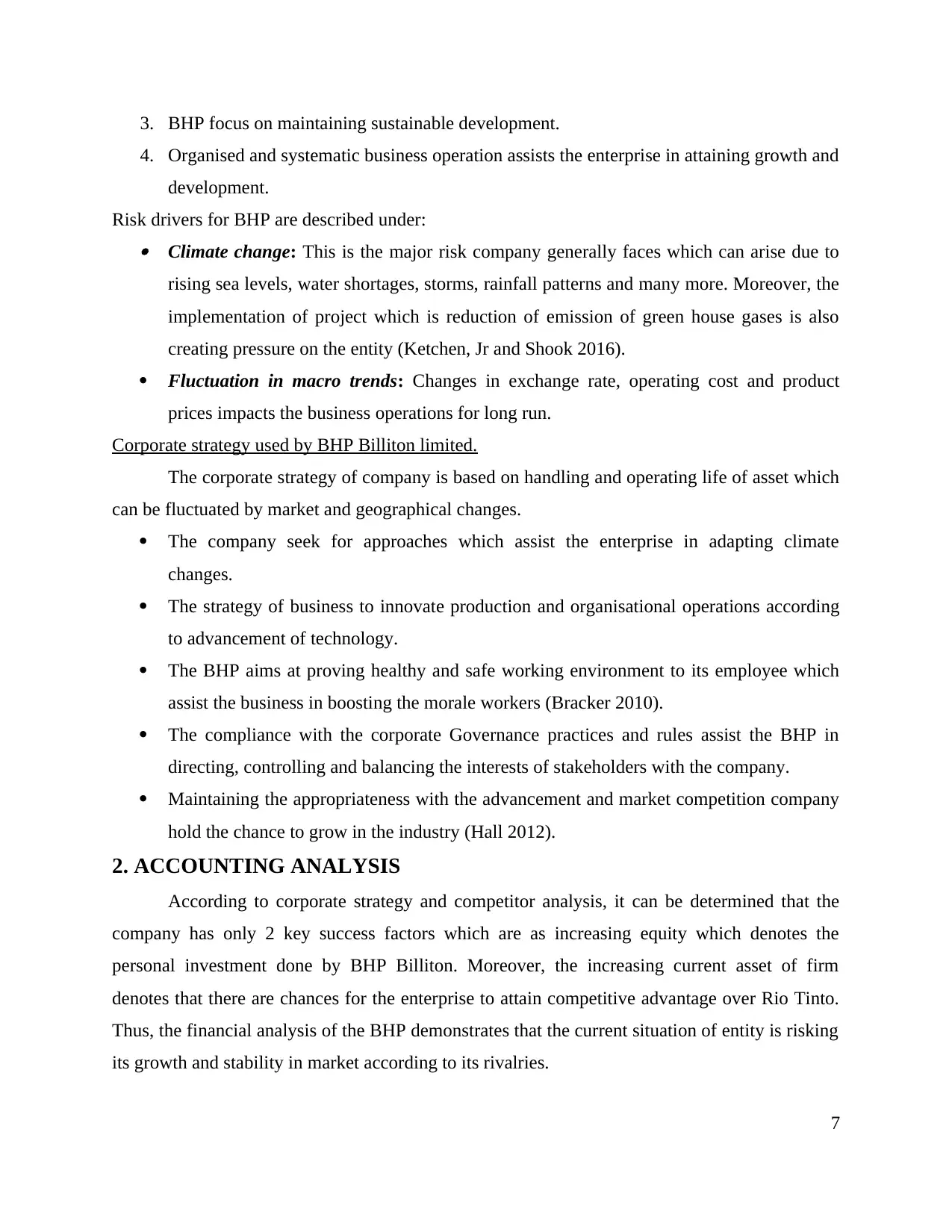
3. BHP focus on maintaining sustainable development.
4. Organised and systematic business operation assists the enterprise in attaining growth and
development.
Risk drivers for BHP are described under: Climate change: This is the major risk company generally faces which can arise due to
rising sea levels, water shortages, storms, rainfall patterns and many more. Moreover, the
implementation of project which is reduction of emission of green house gases is also
creating pressure on the entity (Ketchen, Jr and Shook 2016).
Fluctuation in macro trends: Changes in exchange rate, operating cost and product
prices impacts the business operations for long run.
Corporate strategy used by BHP Billiton limited.
The corporate strategy of company is based on handling and operating life of asset which
can be fluctuated by market and geographical changes.
The company seek for approaches which assist the enterprise in adapting climate
changes.
The strategy of business to innovate production and organisational operations according
to advancement of technology.
The BHP aims at proving healthy and safe working environment to its employee which
assist the business in boosting the morale workers (Bracker 2010).
The compliance with the corporate Governance practices and rules assist the BHP in
directing, controlling and balancing the interests of stakeholders with the company.
Maintaining the appropriateness with the advancement and market competition company
hold the chance to grow in the industry (Hall 2012).
2. ACCOUNTING ANALYSIS
According to corporate strategy and competitor analysis, it can be determined that the
company has only 2 key success factors which are as increasing equity which denotes the
personal investment done by BHP Billiton. Moreover, the increasing current asset of firm
denotes that there are chances for the enterprise to attain competitive advantage over Rio Tinto.
Thus, the financial analysis of the BHP demonstrates that the current situation of entity is risking
its growth and stability in market according to its rivalries.
7
4. Organised and systematic business operation assists the enterprise in attaining growth and
development.
Risk drivers for BHP are described under: Climate change: This is the major risk company generally faces which can arise due to
rising sea levels, water shortages, storms, rainfall patterns and many more. Moreover, the
implementation of project which is reduction of emission of green house gases is also
creating pressure on the entity (Ketchen, Jr and Shook 2016).
Fluctuation in macro trends: Changes in exchange rate, operating cost and product
prices impacts the business operations for long run.
Corporate strategy used by BHP Billiton limited.
The corporate strategy of company is based on handling and operating life of asset which
can be fluctuated by market and geographical changes.
The company seek for approaches which assist the enterprise in adapting climate
changes.
The strategy of business to innovate production and organisational operations according
to advancement of technology.
The BHP aims at proving healthy and safe working environment to its employee which
assist the business in boosting the morale workers (Bracker 2010).
The compliance with the corporate Governance practices and rules assist the BHP in
directing, controlling and balancing the interests of stakeholders with the company.
Maintaining the appropriateness with the advancement and market competition company
hold the chance to grow in the industry (Hall 2012).
2. ACCOUNTING ANALYSIS
According to corporate strategy and competitor analysis, it can be determined that the
company has only 2 key success factors which are as increasing equity which denotes the
personal investment done by BHP Billiton. Moreover, the increasing current asset of firm
denotes that there are chances for the enterprise to attain competitive advantage over Rio Tinto.
Thus, the financial analysis of the BHP demonstrates that the current situation of entity is risking
its growth and stability in market according to its rivalries.
7
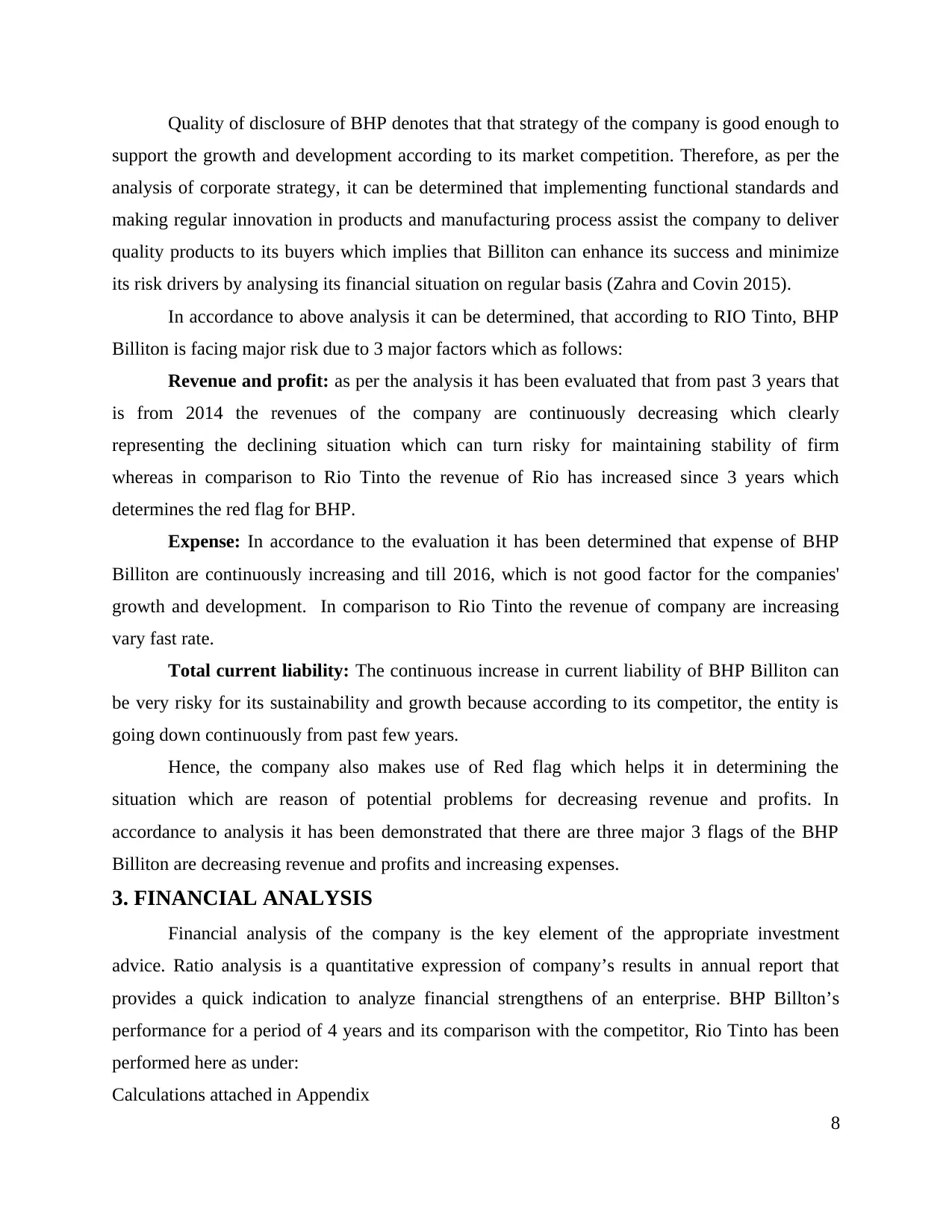
Quality of disclosure of BHP denotes that that strategy of the company is good enough to
support the growth and development according to its market competition. Therefore, as per the
analysis of corporate strategy, it can be determined that implementing functional standards and
making regular innovation in products and manufacturing process assist the company to deliver
quality products to its buyers which implies that Billiton can enhance its success and minimize
its risk drivers by analysing its financial situation on regular basis (Zahra and Covin 2015).
In accordance to above analysis it can be determined, that according to RIO Tinto, BHP
Billiton is facing major risk due to 3 major factors which as follows:
Revenue and profit: as per the analysis it has been evaluated that from past 3 years that
is from 2014 the revenues of the company are continuously decreasing which clearly
representing the declining situation which can turn risky for maintaining stability of firm
whereas in comparison to Rio Tinto the revenue of Rio has increased since 3 years which
determines the red flag for BHP.
Expense: In accordance to the evaluation it has been determined that expense of BHP
Billiton are continuously increasing and till 2016, which is not good factor for the companies'
growth and development. In comparison to Rio Tinto the revenue of company are increasing
vary fast rate.
Total current liability: The continuous increase in current liability of BHP Billiton can
be very risky for its sustainability and growth because according to its competitor, the entity is
going down continuously from past few years.
Hence, the company also makes use of Red flag which helps it in determining the
situation which are reason of potential problems for decreasing revenue and profits. In
accordance to analysis it has been demonstrated that there are three major 3 flags of the BHP
Billiton are decreasing revenue and profits and increasing expenses.
3. FINANCIAL ANALYSIS
Financial analysis of the company is the key element of the appropriate investment
advice. Ratio analysis is a quantitative expression of company’s results in annual report that
provides a quick indication to analyze financial strengthens of an enterprise. BHP Billton’s
performance for a period of 4 years and its comparison with the competitor, Rio Tinto has been
performed here as under:
Calculations attached in Appendix
8
support the growth and development according to its market competition. Therefore, as per the
analysis of corporate strategy, it can be determined that implementing functional standards and
making regular innovation in products and manufacturing process assist the company to deliver
quality products to its buyers which implies that Billiton can enhance its success and minimize
its risk drivers by analysing its financial situation on regular basis (Zahra and Covin 2015).
In accordance to above analysis it can be determined, that according to RIO Tinto, BHP
Billiton is facing major risk due to 3 major factors which as follows:
Revenue and profit: as per the analysis it has been evaluated that from past 3 years that
is from 2014 the revenues of the company are continuously decreasing which clearly
representing the declining situation which can turn risky for maintaining stability of firm
whereas in comparison to Rio Tinto the revenue of Rio has increased since 3 years which
determines the red flag for BHP.
Expense: In accordance to the evaluation it has been determined that expense of BHP
Billiton are continuously increasing and till 2016, which is not good factor for the companies'
growth and development. In comparison to Rio Tinto the revenue of company are increasing
vary fast rate.
Total current liability: The continuous increase in current liability of BHP Billiton can
be very risky for its sustainability and growth because according to its competitor, the entity is
going down continuously from past few years.
Hence, the company also makes use of Red flag which helps it in determining the
situation which are reason of potential problems for decreasing revenue and profits. In
accordance to analysis it has been demonstrated that there are three major 3 flags of the BHP
Billiton are decreasing revenue and profits and increasing expenses.
3. FINANCIAL ANALYSIS
Financial analysis of the company is the key element of the appropriate investment
advice. Ratio analysis is a quantitative expression of company’s results in annual report that
provides a quick indication to analyze financial strengthens of an enterprise. BHP Billton’s
performance for a period of 4 years and its comparison with the competitor, Rio Tinto has been
performed here as under:
Calculations attached in Appendix
8
Secure Best Marks with AI Grader
Need help grading? Try our AI Grader for instant feedback on your assignments.
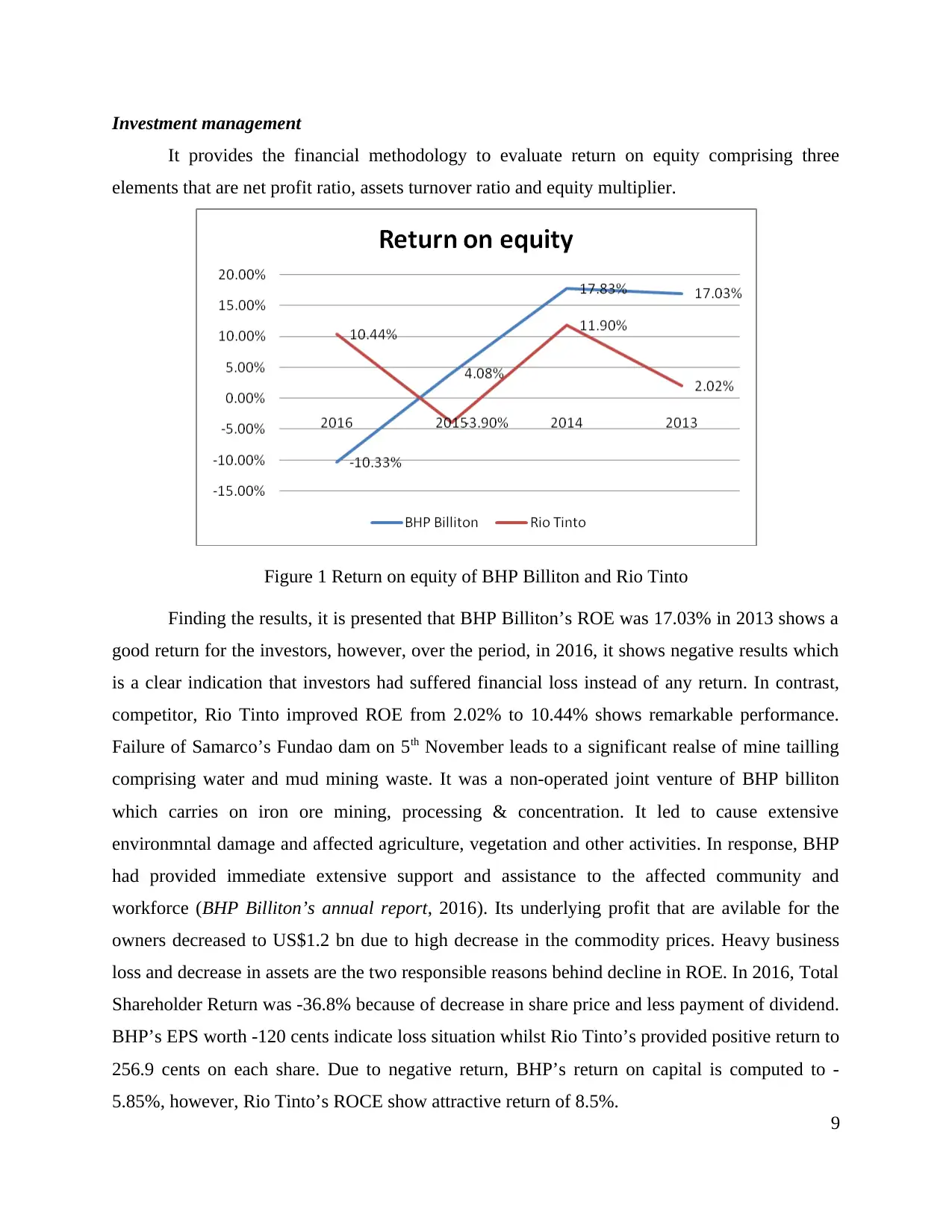
Investment management
It provides the financial methodology to evaluate return on equity comprising three
elements that are net profit ratio, assets turnover ratio and equity multiplier.
Figure 1 Return on equity of BHP Billiton and Rio Tinto
Finding the results, it is presented that BHP Billiton’s ROE was 17.03% in 2013 shows a
good return for the investors, however, over the period, in 2016, it shows negative results which
is a clear indication that investors had suffered financial loss instead of any return. In contrast,
competitor, Rio Tinto improved ROE from 2.02% to 10.44% shows remarkable performance.
Failure of Samarco’s Fundao dam on 5th November leads to a significant realse of mine tailling
comprising water and mud mining waste. It was a non-operated joint venture of BHP billiton
which carries on iron ore mining, processing & concentration. It led to cause extensive
environmntal damage and affected agriculture, vegetation and other activities. In response, BHP
had provided immediate extensive support and assistance to the affected community and
workforce (BHP Billiton’s annual report, 2016). Its underlying profit that are avilable for the
owners decreased to US$1.2 bn due to high decrease in the commodity prices. Heavy business
loss and decrease in assets are the two responsible reasons behind decline in ROE. In 2016, Total
Shareholder Return was -36.8% because of decrease in share price and less payment of dividend.
BHP’s EPS worth -120 cents indicate loss situation whilst Rio Tinto’s provided positive return to
256.9 cents on each share. Due to negative return, BHP’s return on capital is computed to -
5.85%, however, Rio Tinto’s ROCE show attractive return of 8.5%.
9
It provides the financial methodology to evaluate return on equity comprising three
elements that are net profit ratio, assets turnover ratio and equity multiplier.
Figure 1 Return on equity of BHP Billiton and Rio Tinto
Finding the results, it is presented that BHP Billiton’s ROE was 17.03% in 2013 shows a
good return for the investors, however, over the period, in 2016, it shows negative results which
is a clear indication that investors had suffered financial loss instead of any return. In contrast,
competitor, Rio Tinto improved ROE from 2.02% to 10.44% shows remarkable performance.
Failure of Samarco’s Fundao dam on 5th November leads to a significant realse of mine tailling
comprising water and mud mining waste. It was a non-operated joint venture of BHP billiton
which carries on iron ore mining, processing & concentration. It led to cause extensive
environmntal damage and affected agriculture, vegetation and other activities. In response, BHP
had provided immediate extensive support and assistance to the affected community and
workforce (BHP Billiton’s annual report, 2016). Its underlying profit that are avilable for the
owners decreased to US$1.2 bn due to high decrease in the commodity prices. Heavy business
loss and decrease in assets are the two responsible reasons behind decline in ROE. In 2016, Total
Shareholder Return was -36.8% because of decrease in share price and less payment of dividend.
BHP’s EPS worth -120 cents indicate loss situation whilst Rio Tinto’s provided positive return to
256.9 cents on each share. Due to negative return, BHP’s return on capital is computed to -
5.85%, however, Rio Tinto’s ROCE show attractive return of 8.5%.
9
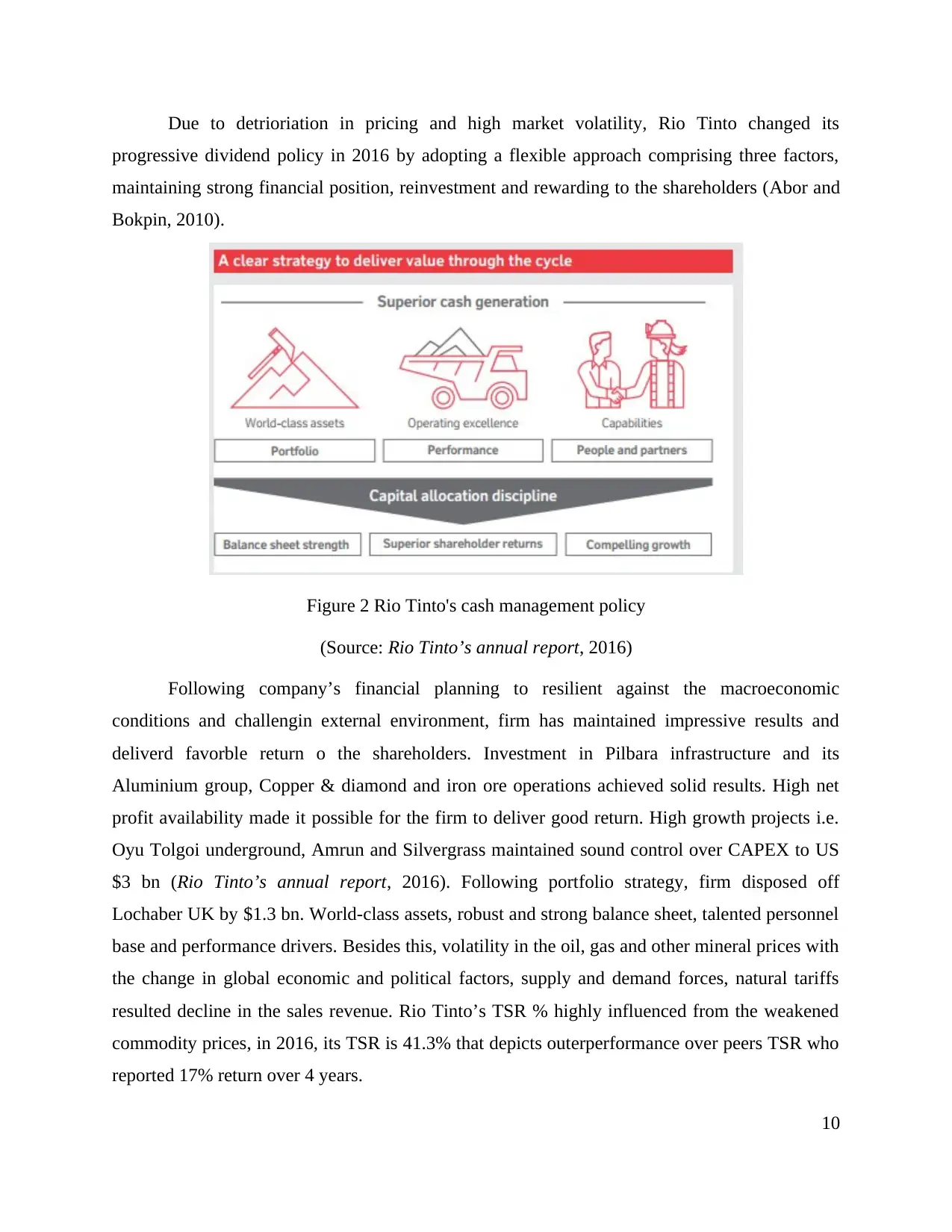
Due to detrioriation in pricing and high market volatility, Rio Tinto changed its
progressive dividend policy in 2016 by adopting a flexible approach comprising three factors,
maintaining strong financial position, reinvestment and rewarding to the shareholders (Abor and
Bokpin, 2010).
Figure 2 Rio Tinto's cash management policy
(Source: Rio Tinto’s annual report, 2016)
Following company’s financial planning to resilient against the macroeconomic
conditions and challengin external environment, firm has maintained impressive results and
deliverd favorble return o the shareholders. Investment in Pilbara infrastructure and its
Aluminium group, Copper & diamond and iron ore operations achieved solid results. High net
profit availability made it possible for the firm to deliver good return. High growth projects i.e.
Oyu Tolgoi underground, Amrun and Silvergrass maintained sound control over CAPEX to US
$3 bn (Rio Tinto’s annual report, 2016). Following portfolio strategy, firm disposed off
Lochaber UK by $1.3 bn. World-class assets, robust and strong balance sheet, talented personnel
base and performance drivers. Besides this, volatility in the oil, gas and other mineral prices with
the change in global economic and political factors, supply and demand forces, natural tariffs
resulted decline in the sales revenue. Rio Tinto’s TSR % highly influenced from the weakened
commodity prices, in 2016, its TSR is 41.3% that depicts outerperformance over peers TSR who
reported 17% return over 4 years.
10
progressive dividend policy in 2016 by adopting a flexible approach comprising three factors,
maintaining strong financial position, reinvestment and rewarding to the shareholders (Abor and
Bokpin, 2010).
Figure 2 Rio Tinto's cash management policy
(Source: Rio Tinto’s annual report, 2016)
Following company’s financial planning to resilient against the macroeconomic
conditions and challengin external environment, firm has maintained impressive results and
deliverd favorble return o the shareholders. Investment in Pilbara infrastructure and its
Aluminium group, Copper & diamond and iron ore operations achieved solid results. High net
profit availability made it possible for the firm to deliver good return. High growth projects i.e.
Oyu Tolgoi underground, Amrun and Silvergrass maintained sound control over CAPEX to US
$3 bn (Rio Tinto’s annual report, 2016). Following portfolio strategy, firm disposed off
Lochaber UK by $1.3 bn. World-class assets, robust and strong balance sheet, talented personnel
base and performance drivers. Besides this, volatility in the oil, gas and other mineral prices with
the change in global economic and political factors, supply and demand forces, natural tariffs
resulted decline in the sales revenue. Rio Tinto’s TSR % highly influenced from the weakened
commodity prices, in 2016, its TSR is 41.3% that depicts outerperformance over peers TSR who
reported 17% return over 4 years.
10
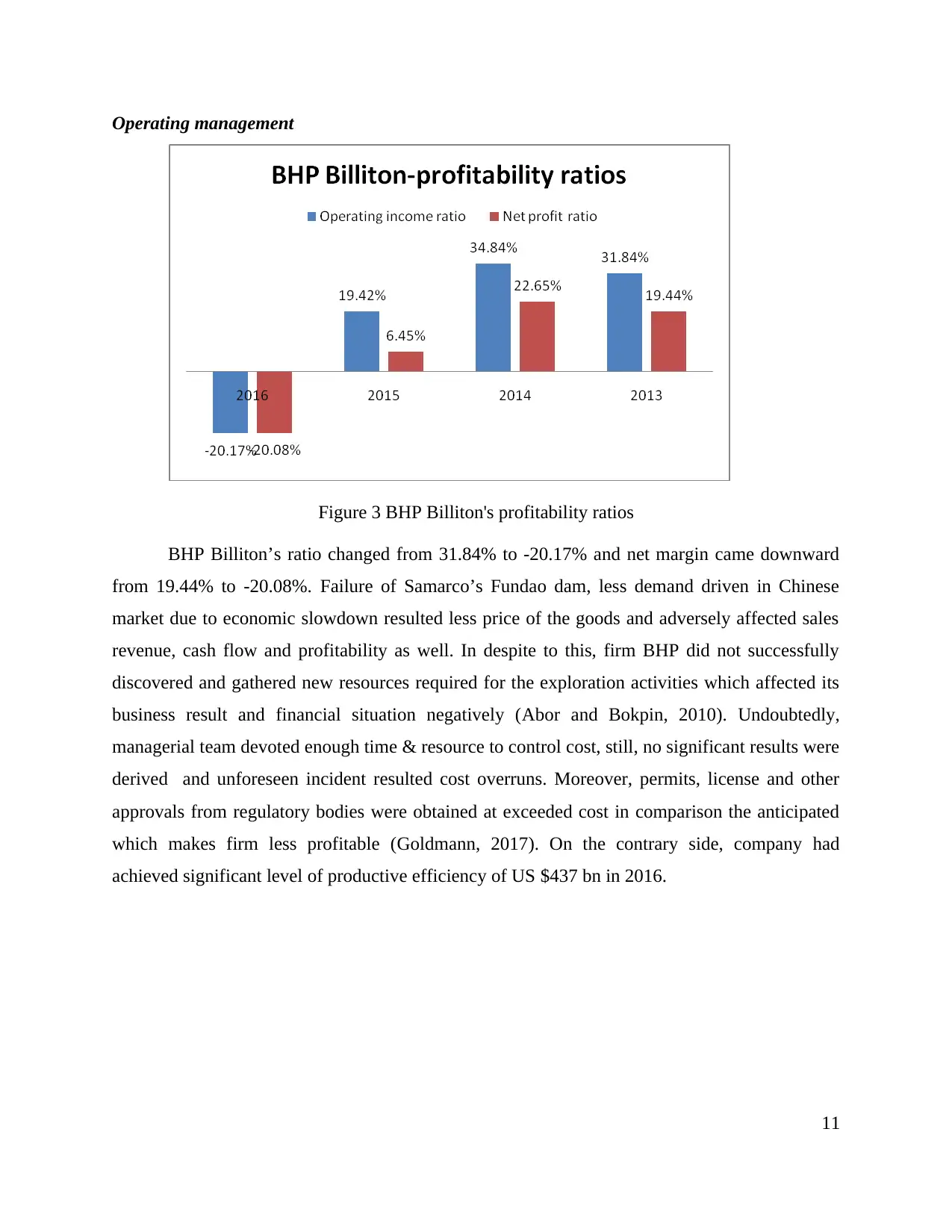
Operating management
Figure 3 BHP Billiton's profitability ratios
BHP Billiton’s ratio changed from 31.84% to -20.17% and net margin came downward
from 19.44% to -20.08%. Failure of Samarco’s Fundao dam, less demand driven in Chinese
market due to economic slowdown resulted less price of the goods and adversely affected sales
revenue, cash flow and profitability as well. In despite to this, firm BHP did not successfully
discovered and gathered new resources required for the exploration activities which affected its
business result and financial situation negatively (Abor and Bokpin, 2010). Undoubtedly,
managerial team devoted enough time & resource to control cost, still, no significant results were
derived and unforeseen incident resulted cost overruns. Moreover, permits, license and other
approvals from regulatory bodies were obtained at exceeded cost in comparison the anticipated
which makes firm less profitable (Goldmann, 2017). On the contrary side, company had
achieved significant level of productive efficiency of US $437 bn in 2016.
11
Figure 3 BHP Billiton's profitability ratios
BHP Billiton’s ratio changed from 31.84% to -20.17% and net margin came downward
from 19.44% to -20.08%. Failure of Samarco’s Fundao dam, less demand driven in Chinese
market due to economic slowdown resulted less price of the goods and adversely affected sales
revenue, cash flow and profitability as well. In despite to this, firm BHP did not successfully
discovered and gathered new resources required for the exploration activities which affected its
business result and financial situation negatively (Abor and Bokpin, 2010). Undoubtedly,
managerial team devoted enough time & resource to control cost, still, no significant results were
derived and unforeseen incident resulted cost overruns. Moreover, permits, license and other
approvals from regulatory bodies were obtained at exceeded cost in comparison the anticipated
which makes firm less profitable (Goldmann, 2017). On the contrary side, company had
achieved significant level of productive efficiency of US $437 bn in 2016.
11
Paraphrase This Document
Need a fresh take? Get an instant paraphrase of this document with our AI Paraphraser
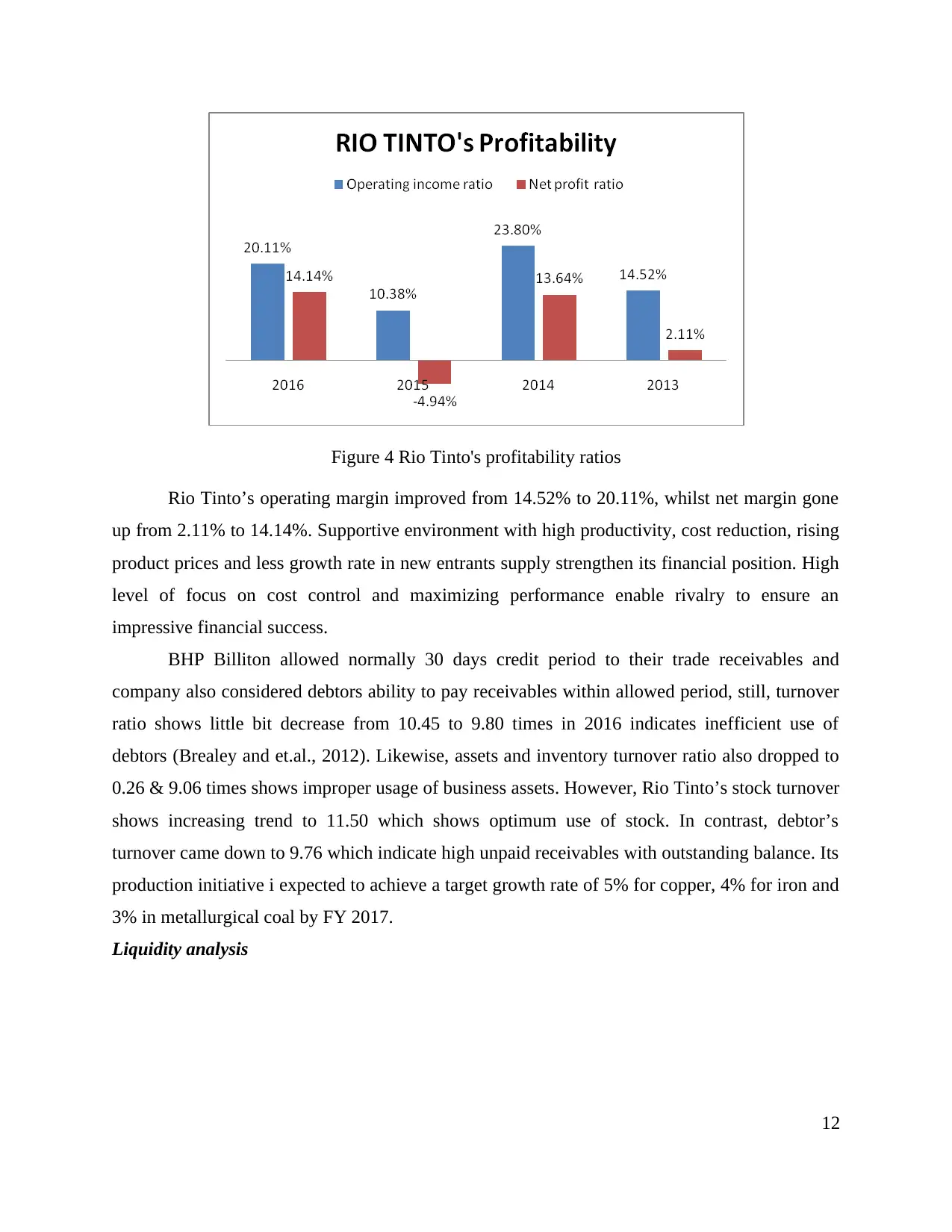
Figure 4 Rio Tinto's profitability ratios
Rio Tinto’s operating margin improved from 14.52% to 20.11%, whilst net margin gone
up from 2.11% to 14.14%. Supportive environment with high productivity, cost reduction, rising
product prices and less growth rate in new entrants supply strengthen its financial position. High
level of focus on cost control and maximizing performance enable rivalry to ensure an
impressive financial success.
BHP Billiton allowed normally 30 days credit period to their trade receivables and
company also considered debtors ability to pay receivables within allowed period, still, turnover
ratio shows little bit decrease from 10.45 to 9.80 times in 2016 indicates inefficient use of
debtors (Brealey and et.al., 2012). Likewise, assets and inventory turnover ratio also dropped to
0.26 & 9.06 times shows improper usage of business assets. However, Rio Tinto’s stock turnover
shows increasing trend to 11.50 which shows optimum use of stock. In contrast, debtor’s
turnover came down to 9.76 which indicate high unpaid receivables with outstanding balance. Its
production initiative i expected to achieve a target growth rate of 5% for copper, 4% for iron and
3% in metallurgical coal by FY 2017.
Liquidity analysis
12
Rio Tinto’s operating margin improved from 14.52% to 20.11%, whilst net margin gone
up from 2.11% to 14.14%. Supportive environment with high productivity, cost reduction, rising
product prices and less growth rate in new entrants supply strengthen its financial position. High
level of focus on cost control and maximizing performance enable rivalry to ensure an
impressive financial success.
BHP Billiton allowed normally 30 days credit period to their trade receivables and
company also considered debtors ability to pay receivables within allowed period, still, turnover
ratio shows little bit decrease from 10.45 to 9.80 times in 2016 indicates inefficient use of
debtors (Brealey and et.al., 2012). Likewise, assets and inventory turnover ratio also dropped to
0.26 & 9.06 times shows improper usage of business assets. However, Rio Tinto’s stock turnover
shows increasing trend to 11.50 which shows optimum use of stock. In contrast, debtor’s
turnover came down to 9.76 which indicate high unpaid receivables with outstanding balance. Its
production initiative i expected to achieve a target growth rate of 5% for copper, 4% for iron and
3% in metallurgical coal by FY 2017.
Liquidity analysis
12
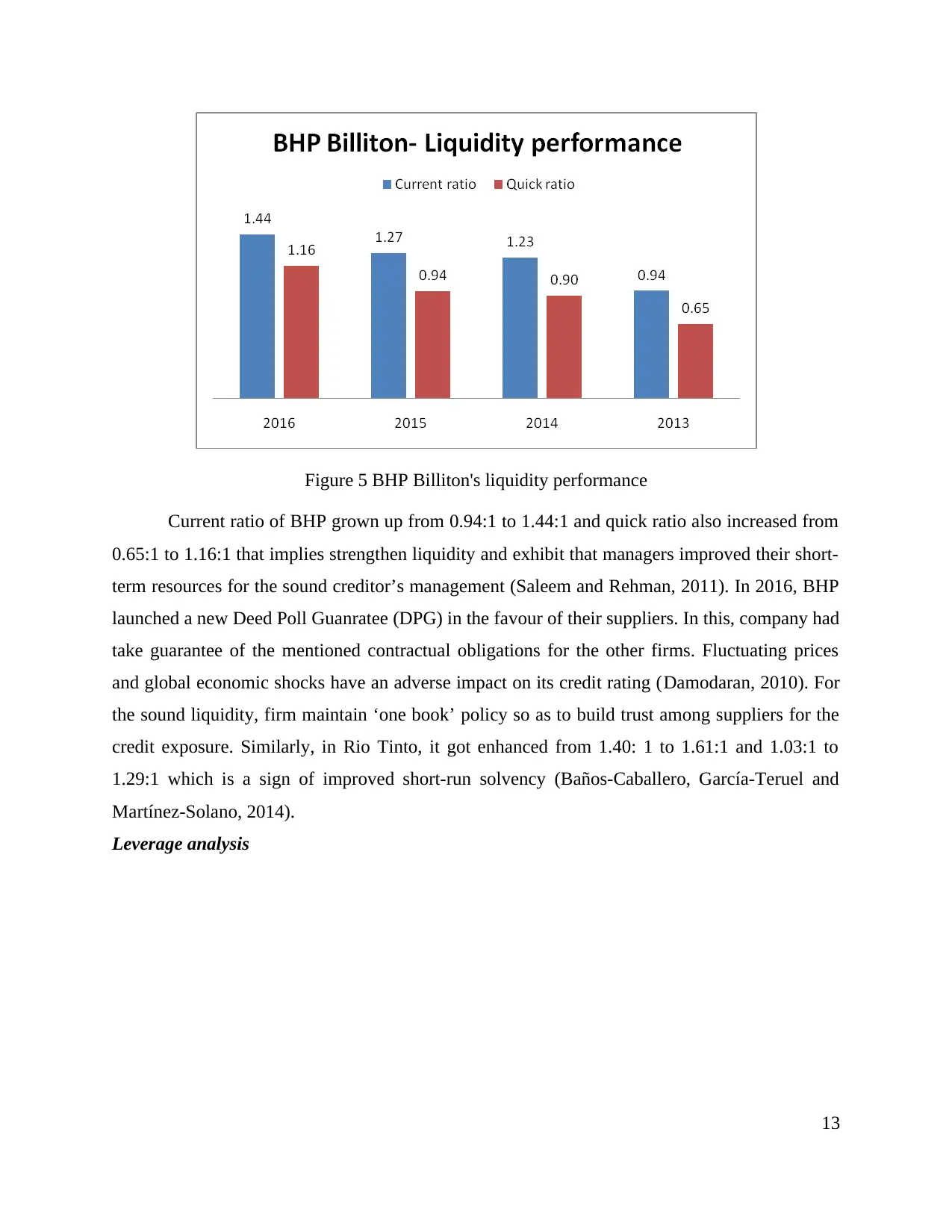
Figure 5 BHP Billiton's liquidity performance
Current ratio of BHP grown up from 0.94:1 to 1.44:1 and quick ratio also increased from
0.65:1 to 1.16:1 that implies strengthen liquidity and exhibit that managers improved their short-
term resources for the sound creditor’s management (Saleem and Rehman, 2011). In 2016, BHP
launched a new Deed Poll Guanratee (DPG) in the favour of their suppliers. In this, company had
take guarantee of the mentioned contractual obligations for the other firms. Fluctuating prices
and global economic shocks have an adverse impact on its credit rating (Damodaran, 2010). For
the sound liquidity, firm maintain ‘one book’ policy so as to build trust among suppliers for the
credit exposure. Similarly, in Rio Tinto, it got enhanced from 1.40: 1 to 1.61:1 and 1.03:1 to
1.29:1 which is a sign of improved short-run solvency (Baños-Caballero, García-Teruel and
Martínez-Solano, 2014).
Leverage analysis
13
Current ratio of BHP grown up from 0.94:1 to 1.44:1 and quick ratio also increased from
0.65:1 to 1.16:1 that implies strengthen liquidity and exhibit that managers improved their short-
term resources for the sound creditor’s management (Saleem and Rehman, 2011). In 2016, BHP
launched a new Deed Poll Guanratee (DPG) in the favour of their suppliers. In this, company had
take guarantee of the mentioned contractual obligations for the other firms. Fluctuating prices
and global economic shocks have an adverse impact on its credit rating (Damodaran, 2010). For
the sound liquidity, firm maintain ‘one book’ policy so as to build trust among suppliers for the
credit exposure. Similarly, in Rio Tinto, it got enhanced from 1.40: 1 to 1.61:1 and 1.03:1 to
1.29:1 which is a sign of improved short-run solvency (Baños-Caballero, García-Teruel and
Martínez-Solano, 2014).
Leverage analysis
13
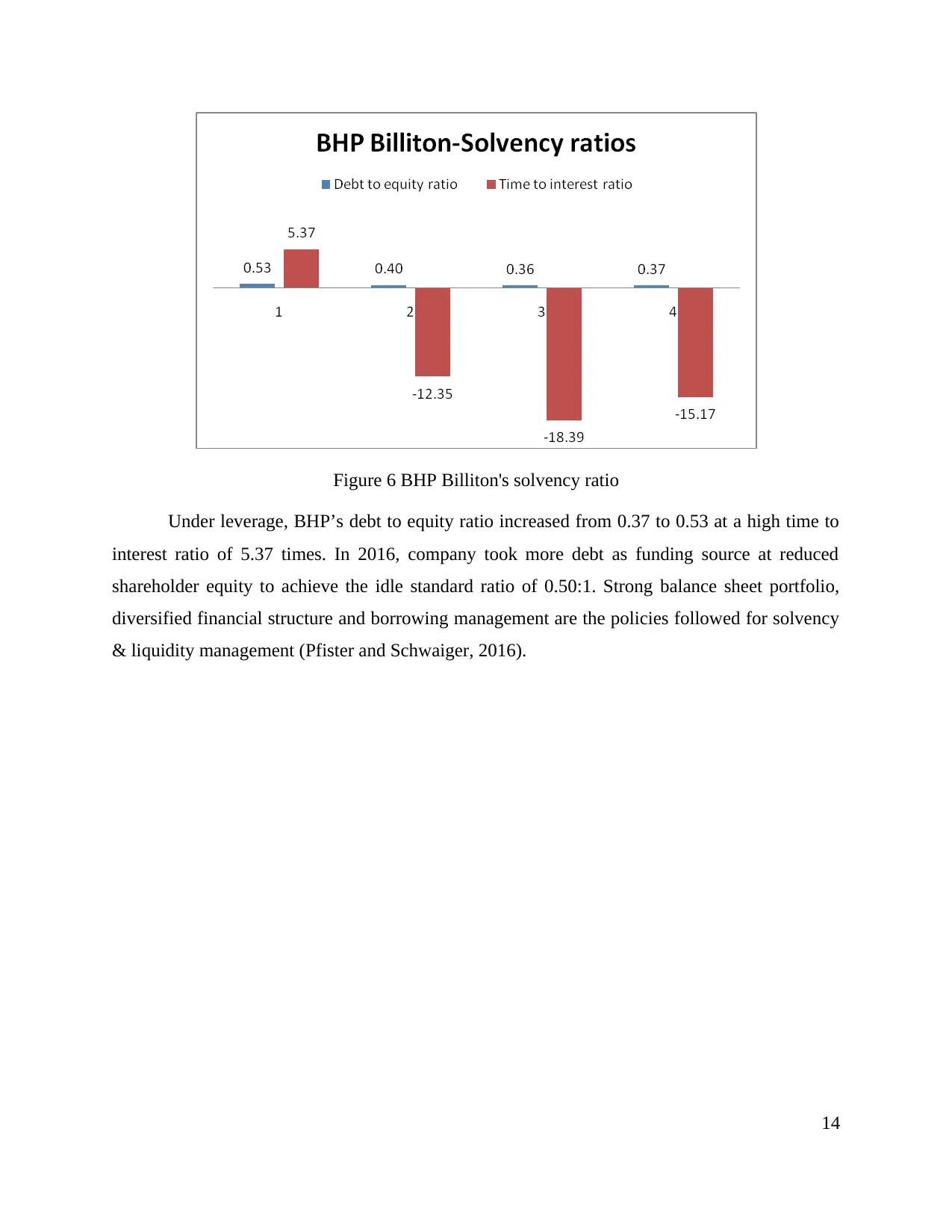
Figure 6 BHP Billiton's solvency ratio
Under leverage, BHP’s debt to equity ratio increased from 0.37 to 0.53 at a high time to
interest ratio of 5.37 times. In 2016, company took more debt as funding source at reduced
shareholder equity to achieve the idle standard ratio of 0.50:1. Strong balance sheet portfolio,
diversified financial structure and borrowing management are the policies followed for solvency
& liquidity management (Pfister and Schwaiger, 2016).
14
Under leverage, BHP’s debt to equity ratio increased from 0.37 to 0.53 at a high time to
interest ratio of 5.37 times. In 2016, company took more debt as funding source at reduced
shareholder equity to achieve the idle standard ratio of 0.50:1. Strong balance sheet portfolio,
diversified financial structure and borrowing management are the policies followed for solvency
& liquidity management (Pfister and Schwaiger, 2016).
14
Secure Best Marks with AI Grader
Need help grading? Try our AI Grader for instant feedback on your assignments.
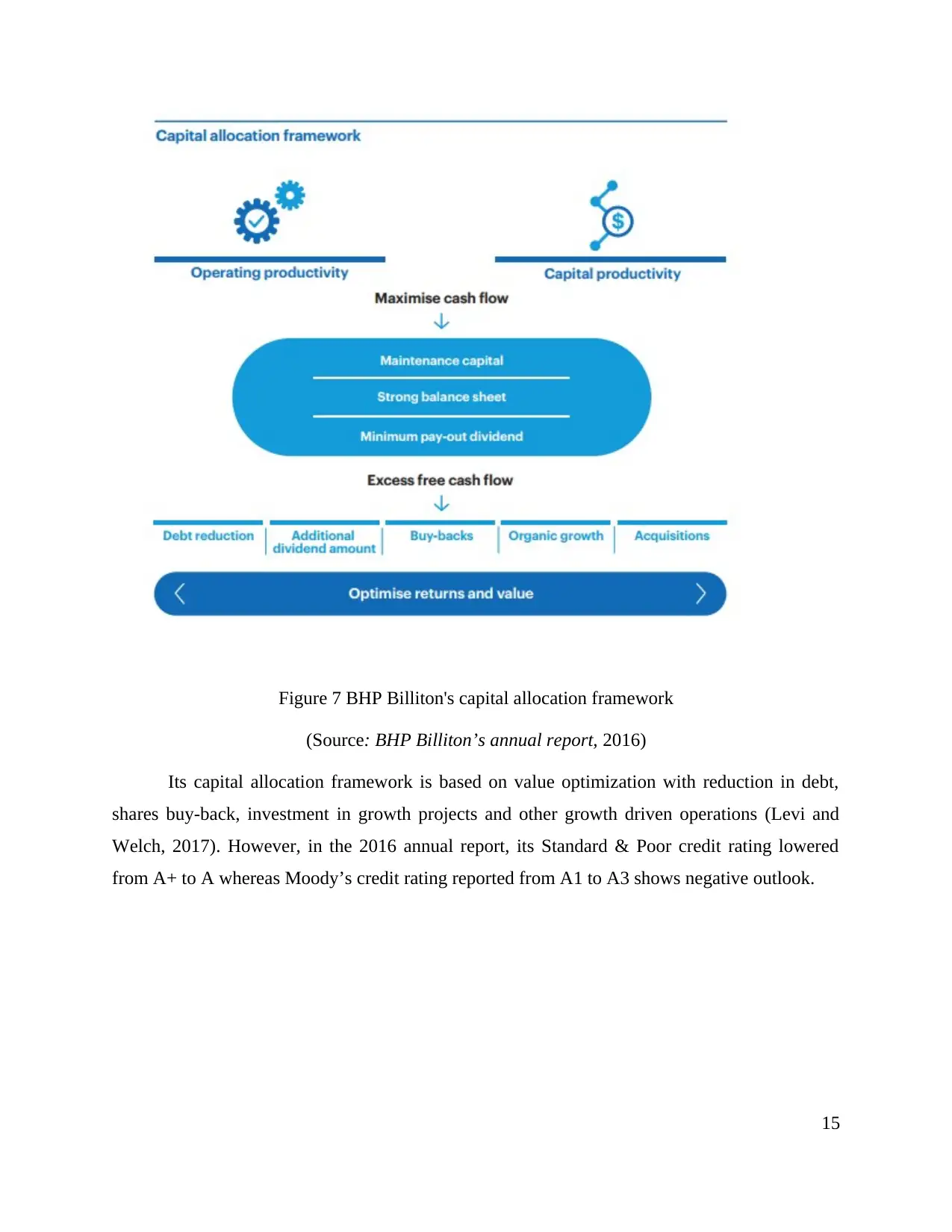
Figure 7 BHP Billiton's capital allocation framework
(Source: BHP Billiton’s annual report, 2016)
Its capital allocation framework is based on value optimization with reduction in debt,
shares buy-back, investment in growth projects and other growth driven operations (Levi and
Welch, 2017). However, in the 2016 annual report, its Standard & Poor credit rating lowered
from A+ to A whereas Moody’s credit rating reported from A1 to A3 shows negative outlook.
15
(Source: BHP Billiton’s annual report, 2016)
Its capital allocation framework is based on value optimization with reduction in debt,
shares buy-back, investment in growth projects and other growth driven operations (Levi and
Welch, 2017). However, in the 2016 annual report, its Standard & Poor credit rating lowered
from A+ to A whereas Moody’s credit rating reported from A1 to A3 shows negative outlook.
15
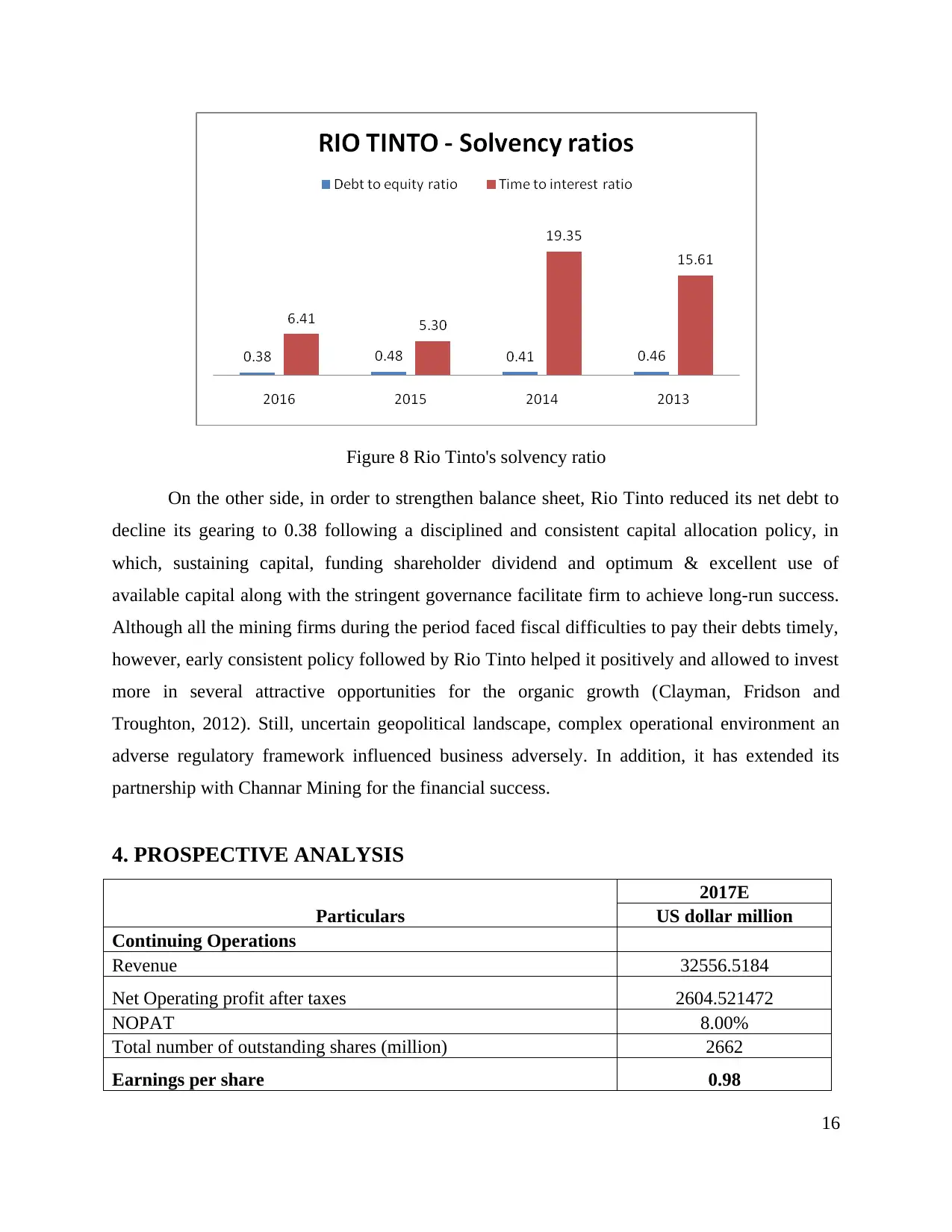
Figure 8 Rio Tinto's solvency ratio
On the other side, in order to strengthen balance sheet, Rio Tinto reduced its net debt to
decline its gearing to 0.38 following a disciplined and consistent capital allocation policy, in
which, sustaining capital, funding shareholder dividend and optimum & excellent use of
available capital along with the stringent governance facilitate firm to achieve long-run success.
Although all the mining firms during the period faced fiscal difficulties to pay their debts timely,
however, early consistent policy followed by Rio Tinto helped it positively and allowed to invest
more in several attractive opportunities for the organic growth (Clayman, Fridson and
Troughton, 2012). Still, uncertain geopolitical landscape, complex operational environment an
adverse regulatory framework influenced business adversely. In addition, it has extended its
partnership with Channar Mining for the financial success.
4. PROSPECTIVE ANALYSIS
Particulars
2017E
US dollar million
Continuing Operations
Revenue 32556.5184
Net Operating profit after taxes 2604.521472
NOPAT 8.00%
Total number of outstanding shares (million) 2662
Earnings per share 0.98
16
On the other side, in order to strengthen balance sheet, Rio Tinto reduced its net debt to
decline its gearing to 0.38 following a disciplined and consistent capital allocation policy, in
which, sustaining capital, funding shareholder dividend and optimum & excellent use of
available capital along with the stringent governance facilitate firm to achieve long-run success.
Although all the mining firms during the period faced fiscal difficulties to pay their debts timely,
however, early consistent policy followed by Rio Tinto helped it positively and allowed to invest
more in several attractive opportunities for the organic growth (Clayman, Fridson and
Troughton, 2012). Still, uncertain geopolitical landscape, complex operational environment an
adverse regulatory framework influenced business adversely. In addition, it has extended its
partnership with Channar Mining for the financial success.
4. PROSPECTIVE ANALYSIS
Particulars
2017E
US dollar million
Continuing Operations
Revenue 32556.5184
Net Operating profit after taxes 2604.521472
NOPAT 8.00%
Total number of outstanding shares (million) 2662
Earnings per share 0.98
16

3 Year average price to earnings ratio 24.6
Current price to earnings ratio 45
Share price 24.06883103
Revenue projection
Revenue 2016 2015 2014 Average
Year on Year -30.75% -33.58% 1.90% -20.81%
3-Year average -22.33% -14.82% -2.15% -13.10%
5-Year average -15.50% -3.30% 6.00% -4.27%
10-Year average 0.39% 4.20% 11.37% 5.32%
Australia is among the top five biggest producers of minerals i.e. gold, Iron, nickel, zinc,
lead and others, still, currently the mining sector is experiencing economic fluctuations and
volatility due to changing prices. From the analysis performed above, it is founded that BHP
Billiton faced excessive loss due to sudden failure of Samarco’s Fundao which was an
unforeseen or unexpected business situation, however, influenced operational activities and
return to a major extent. Therefore, for the sales projection, it is better to use average of 10-year
average sales growth in last (Baker and Martin, 2011). Investment in Pilbara infrastructure and
solid performance of Aluminium group, Copper & diamond and iron ore will bring growth in
sales. Henceforth, 5.32% rate has been used for the purpose of sales growth estimation and it is
derived to US $32,556.65 million. However, NOPAT has been projected using 3-year average of
net income % on sales computed to US $2.604.52 at net profitability of 8%. At this, EPS is
projected to 0.98 whereas 3 year average price to earnings ratio to 24.6 is used as market
multiple which estimated share price to 24.06. However, currently, on 30th June 2017, BHP
Billiton’s share price is estimated to 23.28 which is little bit less than expected (BHP Billiton’s
current share price, 2017).
5. RECOMMENDATION
From the above analysis, it is considered better to advise BHP Billiton that company
should strengthen and tighten control over cost for profit maximization. Besides this, firm must
make decisions to manage risk due to volatile economic outlook i.e. less Chinese demand,
decline in prices and changing regulations. Its new operational model, simplified structure and
streamline working will bring the benefits of economies of scale, minimize duplication and helps
17
Current price to earnings ratio 45
Share price 24.06883103
Revenue projection
Revenue 2016 2015 2014 Average
Year on Year -30.75% -33.58% 1.90% -20.81%
3-Year average -22.33% -14.82% -2.15% -13.10%
5-Year average -15.50% -3.30% 6.00% -4.27%
10-Year average 0.39% 4.20% 11.37% 5.32%
Australia is among the top five biggest producers of minerals i.e. gold, Iron, nickel, zinc,
lead and others, still, currently the mining sector is experiencing economic fluctuations and
volatility due to changing prices. From the analysis performed above, it is founded that BHP
Billiton faced excessive loss due to sudden failure of Samarco’s Fundao which was an
unforeseen or unexpected business situation, however, influenced operational activities and
return to a major extent. Therefore, for the sales projection, it is better to use average of 10-year
average sales growth in last (Baker and Martin, 2011). Investment in Pilbara infrastructure and
solid performance of Aluminium group, Copper & diamond and iron ore will bring growth in
sales. Henceforth, 5.32% rate has been used for the purpose of sales growth estimation and it is
derived to US $32,556.65 million. However, NOPAT has been projected using 3-year average of
net income % on sales computed to US $2.604.52 at net profitability of 8%. At this, EPS is
projected to 0.98 whereas 3 year average price to earnings ratio to 24.6 is used as market
multiple which estimated share price to 24.06. However, currently, on 30th June 2017, BHP
Billiton’s share price is estimated to 23.28 which is little bit less than expected (BHP Billiton’s
current share price, 2017).
5. RECOMMENDATION
From the above analysis, it is considered better to advise BHP Billiton that company
should strengthen and tighten control over cost for profit maximization. Besides this, firm must
make decisions to manage risk due to volatile economic outlook i.e. less Chinese demand,
decline in prices and changing regulations. Its new operational model, simplified structure and
streamline working will bring the benefits of economies of scale, minimize duplication and helps
17
Paraphrase This Document
Need a fresh take? Get an instant paraphrase of this document with our AI Paraphraser
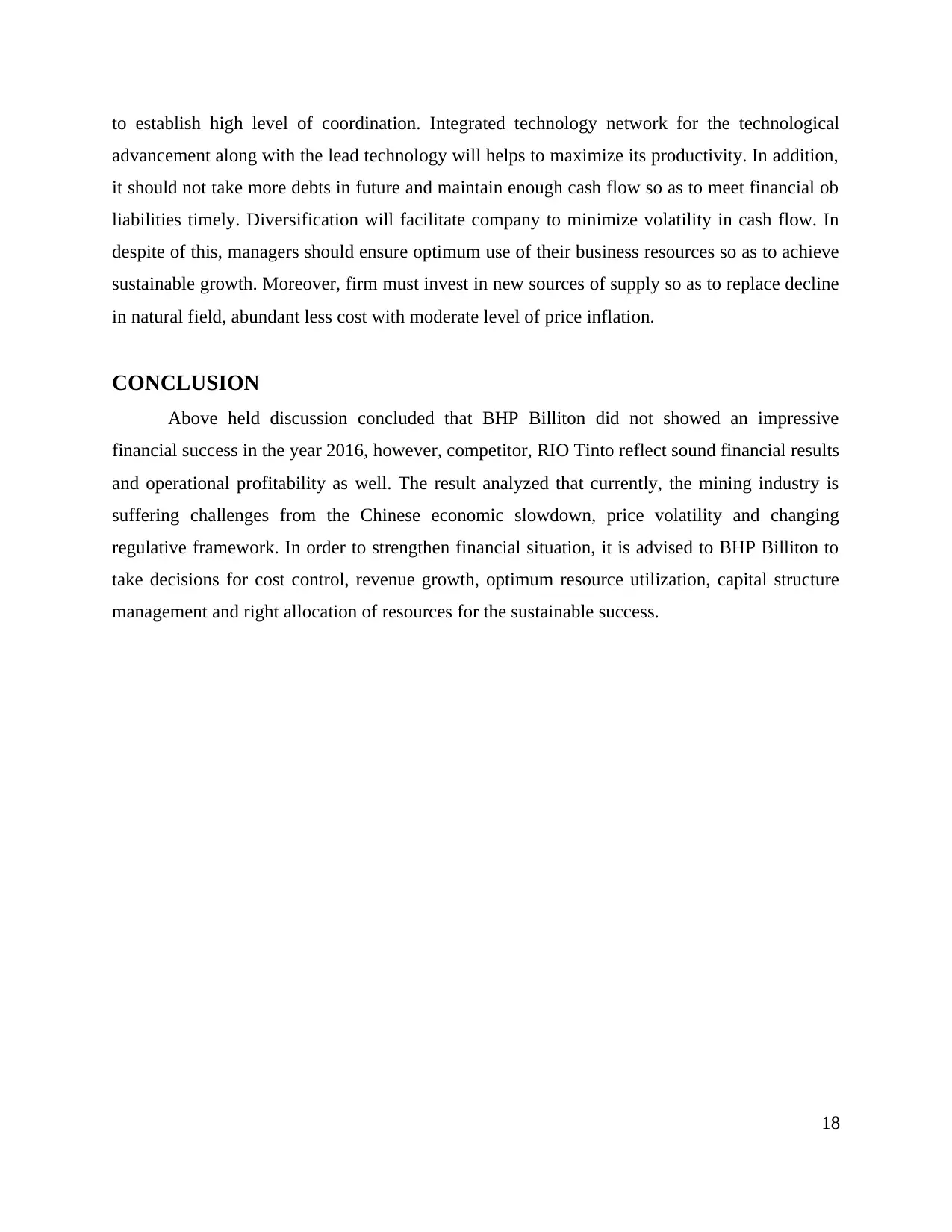
to establish high level of coordination. Integrated technology network for the technological
advancement along with the lead technology will helps to maximize its productivity. In addition,
it should not take more debts in future and maintain enough cash flow so as to meet financial ob
liabilities timely. Diversification will facilitate company to minimize volatility in cash flow. In
despite of this, managers should ensure optimum use of their business resources so as to achieve
sustainable growth. Moreover, firm must invest in new sources of supply so as to replace decline
in natural field, abundant less cost with moderate level of price inflation.
CONCLUSION
Above held discussion concluded that BHP Billiton did not showed an impressive
financial success in the year 2016, however, competitor, RIO Tinto reflect sound financial results
and operational profitability as well. The result analyzed that currently, the mining industry is
suffering challenges from the Chinese economic slowdown, price volatility and changing
regulative framework. In order to strengthen financial situation, it is advised to BHP Billiton to
take decisions for cost control, revenue growth, optimum resource utilization, capital structure
management and right allocation of resources for the sustainable success.
18
advancement along with the lead technology will helps to maximize its productivity. In addition,
it should not take more debts in future and maintain enough cash flow so as to meet financial ob
liabilities timely. Diversification will facilitate company to minimize volatility in cash flow. In
despite of this, managers should ensure optimum use of their business resources so as to achieve
sustainable growth. Moreover, firm must invest in new sources of supply so as to replace decline
in natural field, abundant less cost with moderate level of price inflation.
CONCLUSION
Above held discussion concluded that BHP Billiton did not showed an impressive
financial success in the year 2016, however, competitor, RIO Tinto reflect sound financial results
and operational profitability as well. The result analyzed that currently, the mining industry is
suffering challenges from the Chinese economic slowdown, price volatility and changing
regulative framework. In order to strengthen financial situation, it is advised to BHP Billiton to
take decisions for cost control, revenue growth, optimum resource utilization, capital structure
management and right allocation of resources for the sustainable success.
18
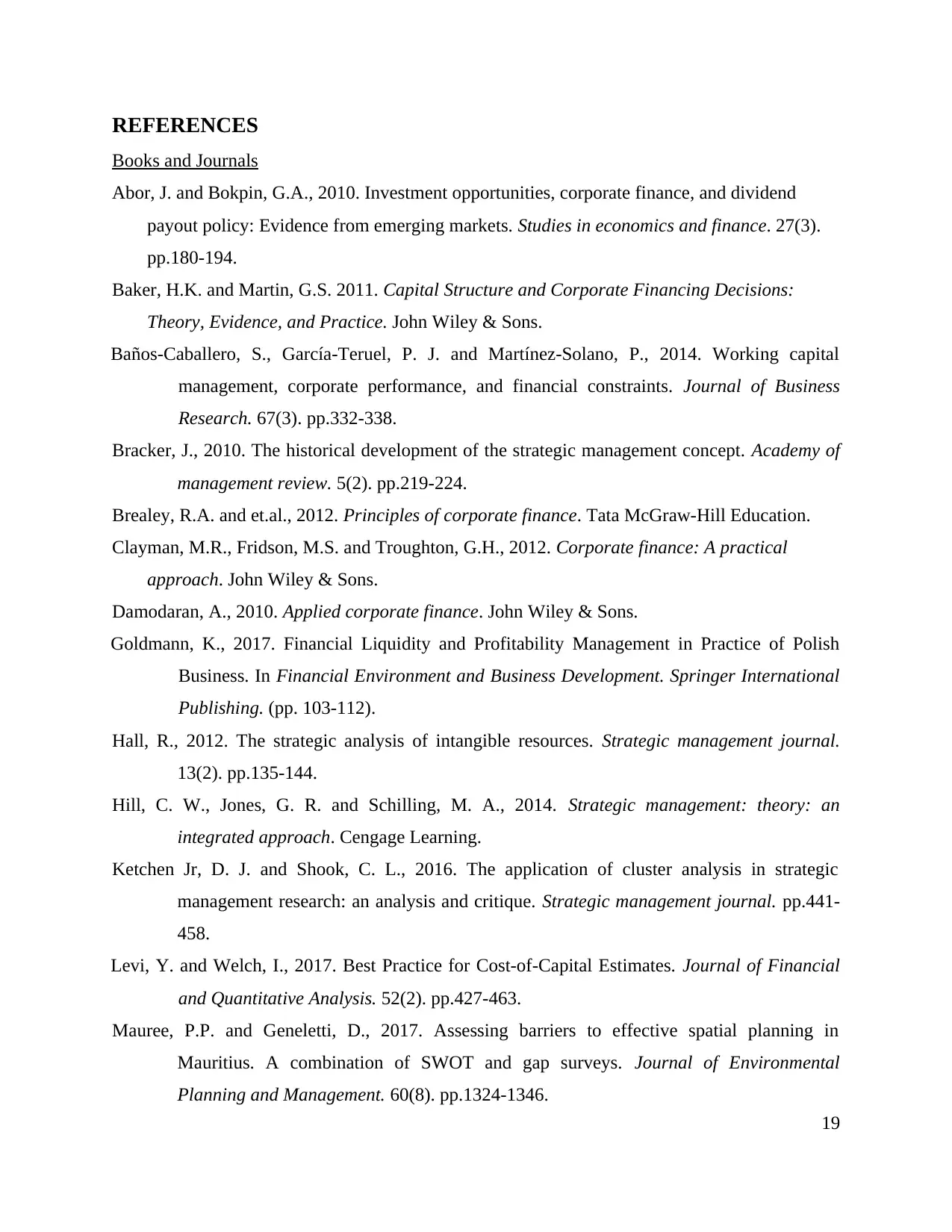
REFERENCES
Books and Journals
Abor, J. and Bokpin, G.A., 2010. Investment opportunities, corporate finance, and dividend
payout policy: Evidence from emerging markets. Studies in economics and finance. 27(3).
pp.180-194.
Baker, H.K. and Martin, G.S. 2011. Capital Structure and Corporate Financing Decisions:
Theory, Evidence, and Practice. John Wiley & Sons.
Baños-Caballero, S., García-Teruel, P. J. and Martínez-Solano, P., 2014. Working capital
management, corporate performance, and financial constraints. Journal of Business
Research. 67(3). pp.332-338.
Bracker, J., 2010. The historical development of the strategic management concept. Academy of
management review. 5(2). pp.219-224.
Brealey, R.A. and et.al., 2012. Principles of corporate finance. Tata McGraw-Hill Education.
Clayman, M.R., Fridson, M.S. and Troughton, G.H., 2012. Corporate finance: A practical
approach. John Wiley & Sons.
Damodaran, A., 2010. Applied corporate finance. John Wiley & Sons.
Goldmann, K., 2017. Financial Liquidity and Profitability Management in Practice of Polish
Business. In Financial Environment and Business Development. Springer International
Publishing. (pp. 103-112).
Hall, R., 2012. The strategic analysis of intangible resources. Strategic management journal.
13(2). pp.135-144.
Hill, C. W., Jones, G. R. and Schilling, M. A., 2014. Strategic management: theory: an
integrated approach. Cengage Learning.
Ketchen Jr, D. J. and Shook, C. L., 2016. The application of cluster analysis in strategic
management research: an analysis and critique. Strategic management journal. pp.441-
458.
Levi, Y. and Welch, I., 2017. Best Practice for Cost-of-Capital Estimates. Journal of Financial
and Quantitative Analysis. 52(2). pp.427-463.
Mauree, P.P. and Geneletti, D., 2017. Assessing barriers to effective spatial planning in
Mauritius. A combination of SWOT and gap surveys. Journal of Environmental
Planning and Management. 60(8). pp.1324-1346.
19
Books and Journals
Abor, J. and Bokpin, G.A., 2010. Investment opportunities, corporate finance, and dividend
payout policy: Evidence from emerging markets. Studies in economics and finance. 27(3).
pp.180-194.
Baker, H.K. and Martin, G.S. 2011. Capital Structure and Corporate Financing Decisions:
Theory, Evidence, and Practice. John Wiley & Sons.
Baños-Caballero, S., García-Teruel, P. J. and Martínez-Solano, P., 2014. Working capital
management, corporate performance, and financial constraints. Journal of Business
Research. 67(3). pp.332-338.
Bracker, J., 2010. The historical development of the strategic management concept. Academy of
management review. 5(2). pp.219-224.
Brealey, R.A. and et.al., 2012. Principles of corporate finance. Tata McGraw-Hill Education.
Clayman, M.R., Fridson, M.S. and Troughton, G.H., 2012. Corporate finance: A practical
approach. John Wiley & Sons.
Damodaran, A., 2010. Applied corporate finance. John Wiley & Sons.
Goldmann, K., 2017. Financial Liquidity and Profitability Management in Practice of Polish
Business. In Financial Environment and Business Development. Springer International
Publishing. (pp. 103-112).
Hall, R., 2012. The strategic analysis of intangible resources. Strategic management journal.
13(2). pp.135-144.
Hill, C. W., Jones, G. R. and Schilling, M. A., 2014. Strategic management: theory: an
integrated approach. Cengage Learning.
Ketchen Jr, D. J. and Shook, C. L., 2016. The application of cluster analysis in strategic
management research: an analysis and critique. Strategic management journal. pp.441-
458.
Levi, Y. and Welch, I., 2017. Best Practice for Cost-of-Capital Estimates. Journal of Financial
and Quantitative Analysis. 52(2). pp.427-463.
Mauree, P.P. and Geneletti, D., 2017. Assessing barriers to effective spatial planning in
Mauritius. A combination of SWOT and gap surveys. Journal of Environmental
Planning and Management. 60(8). pp.1324-1346.
19
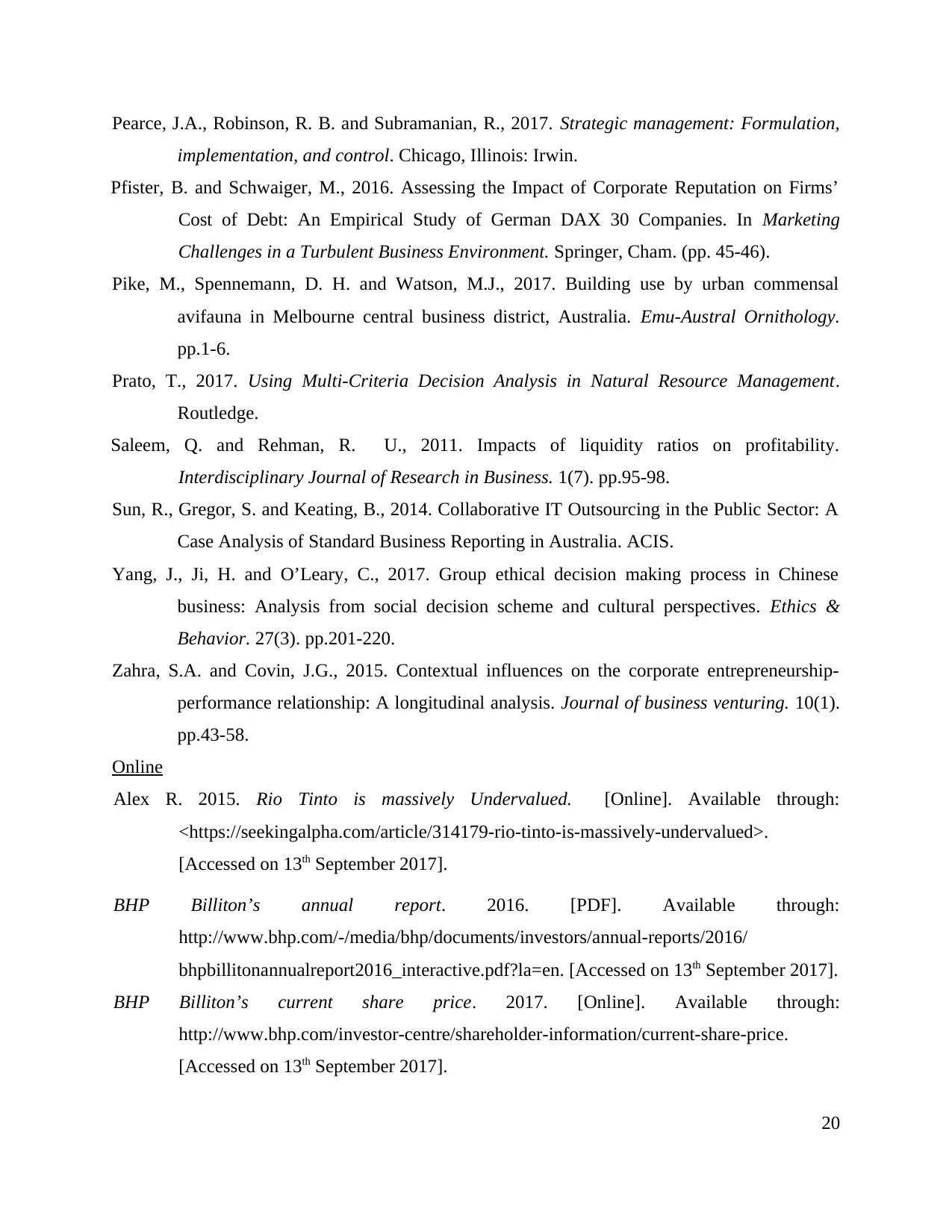
Pearce, J.A., Robinson, R. B. and Subramanian, R., 2017. Strategic management: Formulation,
implementation, and control. Chicago, Illinois: Irwin.
Pfister, B. and Schwaiger, M., 2016. Assessing the Impact of Corporate Reputation on Firms’
Cost of Debt: An Empirical Study of German DAX 30 Companies. In Marketing
Challenges in a Turbulent Business Environment. Springer, Cham. (pp. 45-46).
Pike, M., Spennemann, D. H. and Watson, M.J., 2017. Building use by urban commensal
avifauna in Melbourne central business district, Australia. Emu-Austral Ornithology.
pp.1-6.
Prato, T., 2017. Using Multi-Criteria Decision Analysis in Natural Resource Management.
Routledge.
Saleem, Q. and Rehman, R. U., 2011. Impacts of liquidity ratios on profitability.
Interdisciplinary Journal of Research in Business. 1(7). pp.95-98.
Sun, R., Gregor, S. and Keating, B., 2014. Collaborative IT Outsourcing in the Public Sector: A
Case Analysis of Standard Business Reporting in Australia. ACIS.
Yang, J., Ji, H. and O’Leary, C., 2017. Group ethical decision making process in Chinese
business: Analysis from social decision scheme and cultural perspectives. Ethics &
Behavior. 27(3). pp.201-220.
Zahra, S.A. and Covin, J.G., 2015. Contextual influences on the corporate entrepreneurship-
performance relationship: A longitudinal analysis. Journal of business venturing. 10(1).
pp.43-58.
Online
Alex R. 2015. Rio Tinto is massively Undervalued. [Online]. Available through:
<https://seekingalpha.com/article/314179-rio-tinto-is-massively-undervalued>.
[Accessed on 13th September 2017].
BHP Billiton’s annual report. 2016. [PDF]. Available through:
http://www.bhp.com/-/media/bhp/documents/investors/annual-reports/2016/
bhpbillitonannualreport2016_interactive.pdf?la=en. [Accessed on 13th September 2017].
BHP Billiton’s current share price. 2017. [Online]. Available through:
http://www.bhp.com/investor-centre/shareholder-information/current-share-price.
[Accessed on 13th September 2017].
20
implementation, and control. Chicago, Illinois: Irwin.
Pfister, B. and Schwaiger, M., 2016. Assessing the Impact of Corporate Reputation on Firms’
Cost of Debt: An Empirical Study of German DAX 30 Companies. In Marketing
Challenges in a Turbulent Business Environment. Springer, Cham. (pp. 45-46).
Pike, M., Spennemann, D. H. and Watson, M.J., 2017. Building use by urban commensal
avifauna in Melbourne central business district, Australia. Emu-Austral Ornithology.
pp.1-6.
Prato, T., 2017. Using Multi-Criteria Decision Analysis in Natural Resource Management.
Routledge.
Saleem, Q. and Rehman, R. U., 2011. Impacts of liquidity ratios on profitability.
Interdisciplinary Journal of Research in Business. 1(7). pp.95-98.
Sun, R., Gregor, S. and Keating, B., 2014. Collaborative IT Outsourcing in the Public Sector: A
Case Analysis of Standard Business Reporting in Australia. ACIS.
Yang, J., Ji, H. and O’Leary, C., 2017. Group ethical decision making process in Chinese
business: Analysis from social decision scheme and cultural perspectives. Ethics &
Behavior. 27(3). pp.201-220.
Zahra, S.A. and Covin, J.G., 2015. Contextual influences on the corporate entrepreneurship-
performance relationship: A longitudinal analysis. Journal of business venturing. 10(1).
pp.43-58.
Online
Alex R. 2015. Rio Tinto is massively Undervalued. [Online]. Available through:
<https://seekingalpha.com/article/314179-rio-tinto-is-massively-undervalued>.
[Accessed on 13th September 2017].
BHP Billiton’s annual report. 2016. [PDF]. Available through:
http://www.bhp.com/-/media/bhp/documents/investors/annual-reports/2016/
bhpbillitonannualreport2016_interactive.pdf?la=en. [Accessed on 13th September 2017].
BHP Billiton’s current share price. 2017. [Online]. Available through:
http://www.bhp.com/investor-centre/shareholder-information/current-share-price.
[Accessed on 13th September 2017].
20
Secure Best Marks with AI Grader
Need help grading? Try our AI Grader for instant feedback on your assignments.
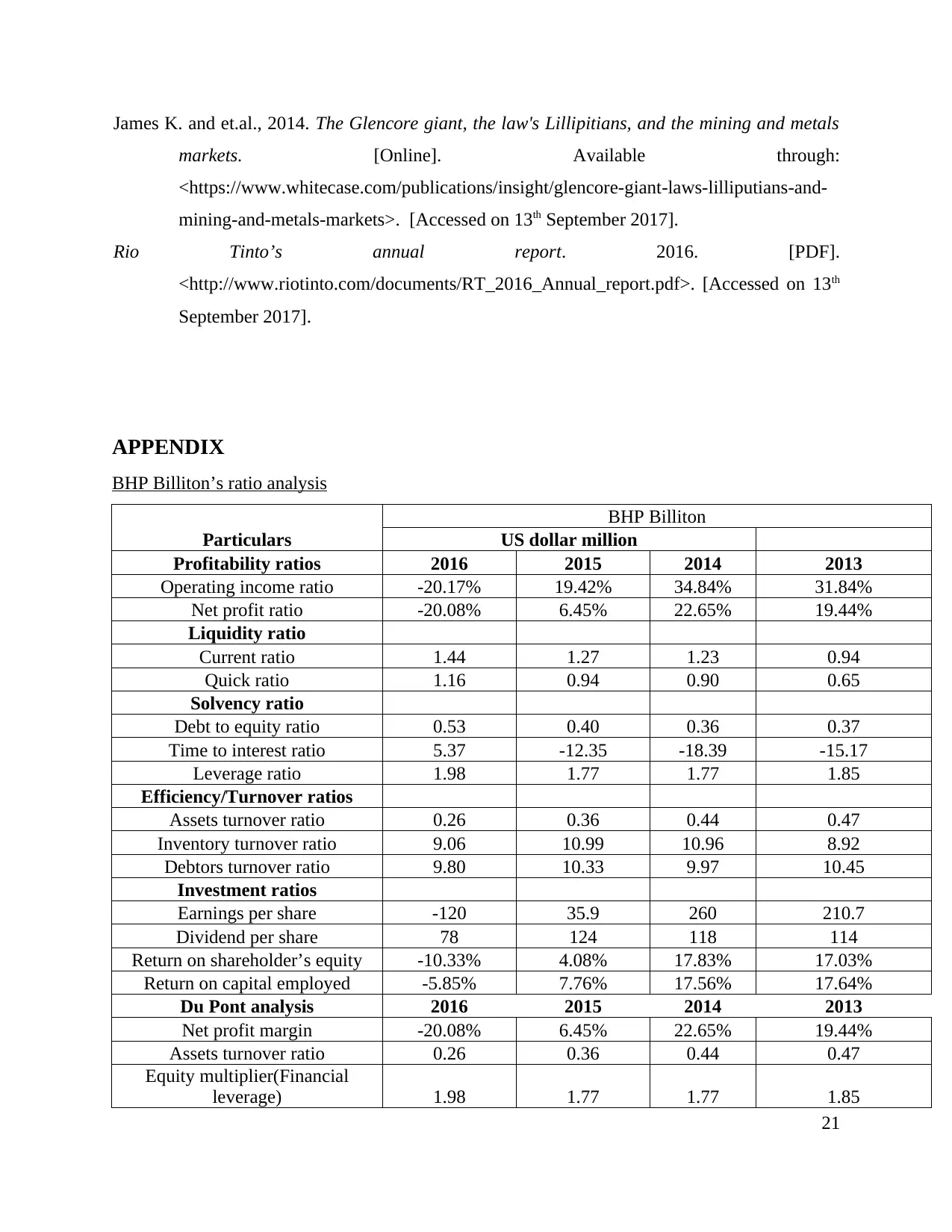
James K. and et.al., 2014. The Glencore giant, the law's Lillipitians, and the mining and metals
markets. [Online]. Available through:
<https://www.whitecase.com/publications/insight/glencore-giant-laws-lilliputians-and-
mining-and-metals-markets>. [Accessed on 13th September 2017].
Rio Tinto’s annual report. 2016. [PDF].
<http://www.riotinto.com/documents/RT_2016_Annual_report.pdf>. [Accessed on 13th
September 2017].
APPENDIX
BHP Billiton’s ratio analysis
Particulars
BHP Billiton
US dollar million
Profitability ratios 2016 2015 2014 2013
Operating income ratio -20.17% 19.42% 34.84% 31.84%
Net profit ratio -20.08% 6.45% 22.65% 19.44%
Liquidity ratio
Current ratio 1.44 1.27 1.23 0.94
Quick ratio 1.16 0.94 0.90 0.65
Solvency ratio
Debt to equity ratio 0.53 0.40 0.36 0.37
Time to interest ratio 5.37 -12.35 -18.39 -15.17
Leverage ratio 1.98 1.77 1.77 1.85
Efficiency/Turnover ratios
Assets turnover ratio 0.26 0.36 0.44 0.47
Inventory turnover ratio 9.06 10.99 10.96 8.92
Debtors turnover ratio 9.80 10.33 9.97 10.45
Investment ratios
Earnings per share -120 35.9 260 210.7
Dividend per share 78 124 118 114
Return on shareholder’s equity -10.33% 4.08% 17.83% 17.03%
Return on capital employed -5.85% 7.76% 17.56% 17.64%
Du Pont analysis 2016 2015 2014 2013
Net profit margin -20.08% 6.45% 22.65% 19.44%
Assets turnover ratio 0.26 0.36 0.44 0.47
Equity multiplier(Financial
leverage) 1.98 1.77 1.77 1.85
21
markets. [Online]. Available through:
<https://www.whitecase.com/publications/insight/glencore-giant-laws-lilliputians-and-
mining-and-metals-markets>. [Accessed on 13th September 2017].
Rio Tinto’s annual report. 2016. [PDF].
<http://www.riotinto.com/documents/RT_2016_Annual_report.pdf>. [Accessed on 13th
September 2017].
APPENDIX
BHP Billiton’s ratio analysis
Particulars
BHP Billiton
US dollar million
Profitability ratios 2016 2015 2014 2013
Operating income ratio -20.17% 19.42% 34.84% 31.84%
Net profit ratio -20.08% 6.45% 22.65% 19.44%
Liquidity ratio
Current ratio 1.44 1.27 1.23 0.94
Quick ratio 1.16 0.94 0.90 0.65
Solvency ratio
Debt to equity ratio 0.53 0.40 0.36 0.37
Time to interest ratio 5.37 -12.35 -18.39 -15.17
Leverage ratio 1.98 1.77 1.77 1.85
Efficiency/Turnover ratios
Assets turnover ratio 0.26 0.36 0.44 0.47
Inventory turnover ratio 9.06 10.99 10.96 8.92
Debtors turnover ratio 9.80 10.33 9.97 10.45
Investment ratios
Earnings per share -120 35.9 260 210.7
Dividend per share 78 124 118 114
Return on shareholder’s equity -10.33% 4.08% 17.83% 17.03%
Return on capital employed -5.85% 7.76% 17.56% 17.64%
Du Pont analysis 2016 2015 2014 2013
Net profit margin -20.08% 6.45% 22.65% 19.44%
Assets turnover ratio 0.26 0.36 0.44 0.47
Equity multiplier(Financial
leverage) 1.98 1.77 1.77 1.85
21
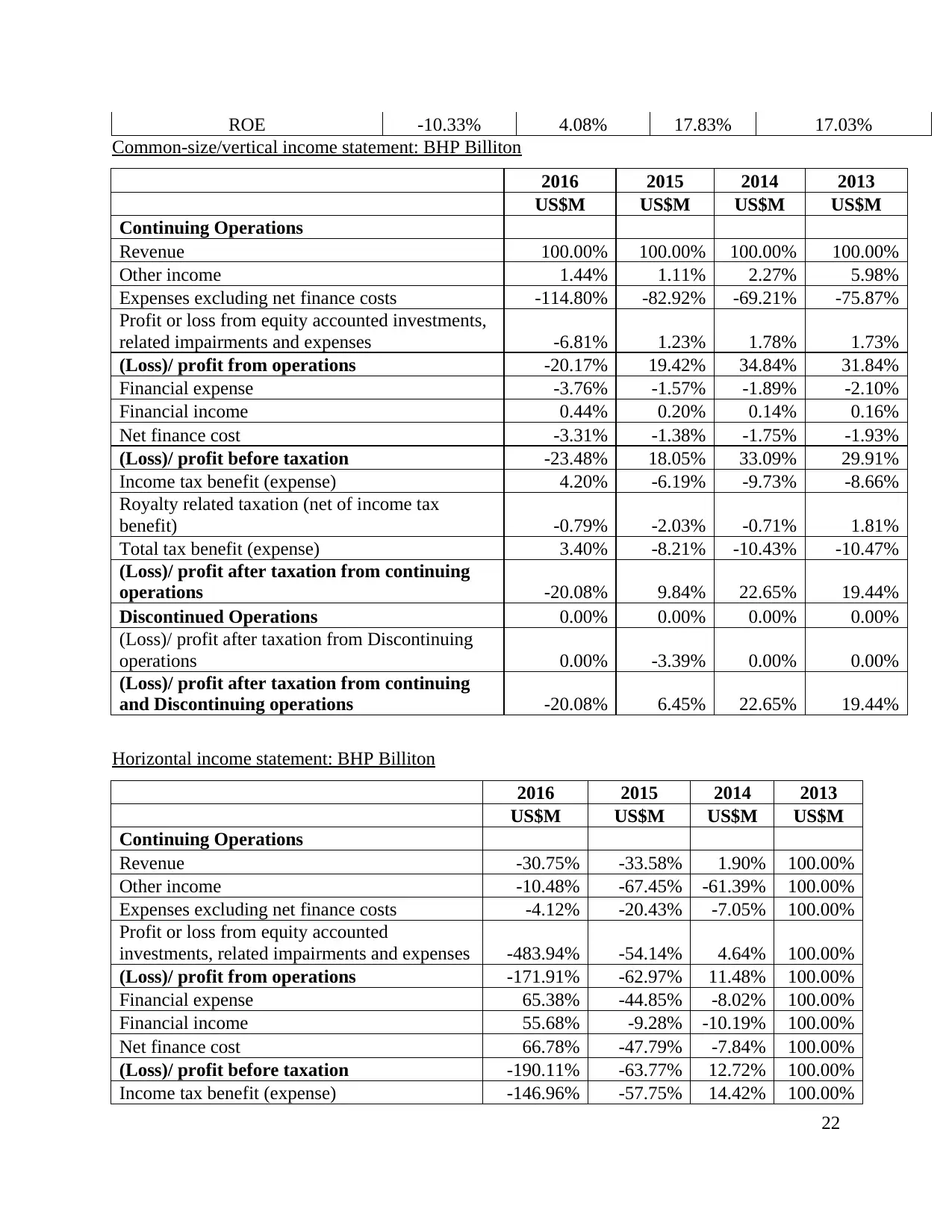
ROE -10.33% 4.08% 17.83% 17.03%
Common-size/vertical income statement: BHP Billiton
2016 2015 2014 2013
US$M US$M US$M US$M
Continuing Operations
Revenue 100.00% 100.00% 100.00% 100.00%
Other income 1.44% 1.11% 2.27% 5.98%
Expenses excluding net finance costs -114.80% -82.92% -69.21% -75.87%
Profit or loss from equity accounted investments,
related impairments and expenses -6.81% 1.23% 1.78% 1.73%
(Loss)/ profit from operations -20.17% 19.42% 34.84% 31.84%
Financial expense -3.76% -1.57% -1.89% -2.10%
Financial income 0.44% 0.20% 0.14% 0.16%
Net finance cost -3.31% -1.38% -1.75% -1.93%
(Loss)/ profit before taxation -23.48% 18.05% 33.09% 29.91%
Income tax benefit (expense) 4.20% -6.19% -9.73% -8.66%
Royalty related taxation (net of income tax
benefit) -0.79% -2.03% -0.71% 1.81%
Total tax benefit (expense) 3.40% -8.21% -10.43% -10.47%
(Loss)/ profit after taxation from continuing
operations -20.08% 9.84% 22.65% 19.44%
Discontinued Operations 0.00% 0.00% 0.00% 0.00%
(Loss)/ profit after taxation from Discontinuing
operations 0.00% -3.39% 0.00% 0.00%
(Loss)/ profit after taxation from continuing
and Discontinuing operations -20.08% 6.45% 22.65% 19.44%
Horizontal income statement: BHP Billiton
2016 2015 2014 2013
US$M US$M US$M US$M
Continuing Operations
Revenue -30.75% -33.58% 1.90% 100.00%
Other income -10.48% -67.45% -61.39% 100.00%
Expenses excluding net finance costs -4.12% -20.43% -7.05% 100.00%
Profit or loss from equity accounted
investments, related impairments and expenses -483.94% -54.14% 4.64% 100.00%
(Loss)/ profit from operations -171.91% -62.97% 11.48% 100.00%
Financial expense 65.38% -44.85% -8.02% 100.00%
Financial income 55.68% -9.28% -10.19% 100.00%
Net finance cost 66.78% -47.79% -7.84% 100.00%
(Loss)/ profit before taxation -190.11% -63.77% 12.72% 100.00%
Income tax benefit (expense) -146.96% -57.75% 14.42% 100.00%
22
Common-size/vertical income statement: BHP Billiton
2016 2015 2014 2013
US$M US$M US$M US$M
Continuing Operations
Revenue 100.00% 100.00% 100.00% 100.00%
Other income 1.44% 1.11% 2.27% 5.98%
Expenses excluding net finance costs -114.80% -82.92% -69.21% -75.87%
Profit or loss from equity accounted investments,
related impairments and expenses -6.81% 1.23% 1.78% 1.73%
(Loss)/ profit from operations -20.17% 19.42% 34.84% 31.84%
Financial expense -3.76% -1.57% -1.89% -2.10%
Financial income 0.44% 0.20% 0.14% 0.16%
Net finance cost -3.31% -1.38% -1.75% -1.93%
(Loss)/ profit before taxation -23.48% 18.05% 33.09% 29.91%
Income tax benefit (expense) 4.20% -6.19% -9.73% -8.66%
Royalty related taxation (net of income tax
benefit) -0.79% -2.03% -0.71% 1.81%
Total tax benefit (expense) 3.40% -8.21% -10.43% -10.47%
(Loss)/ profit after taxation from continuing
operations -20.08% 9.84% 22.65% 19.44%
Discontinued Operations 0.00% 0.00% 0.00% 0.00%
(Loss)/ profit after taxation from Discontinuing
operations 0.00% -3.39% 0.00% 0.00%
(Loss)/ profit after taxation from continuing
and Discontinuing operations -20.08% 6.45% 22.65% 19.44%
Horizontal income statement: BHP Billiton
2016 2015 2014 2013
US$M US$M US$M US$M
Continuing Operations
Revenue -30.75% -33.58% 1.90% 100.00%
Other income -10.48% -67.45% -61.39% 100.00%
Expenses excluding net finance costs -4.12% -20.43% -7.05% 100.00%
Profit or loss from equity accounted
investments, related impairments and expenses -483.94% -54.14% 4.64% 100.00%
(Loss)/ profit from operations -171.91% -62.97% 11.48% 100.00%
Financial expense 65.38% -44.85% -8.02% 100.00%
Financial income 55.68% -9.28% -10.19% 100.00%
Net finance cost 66.78% -47.79% -7.84% 100.00%
(Loss)/ profit before taxation -190.11% -63.77% 12.72% 100.00%
Income tax benefit (expense) -146.96% -57.75% 14.42% 100.00%
22
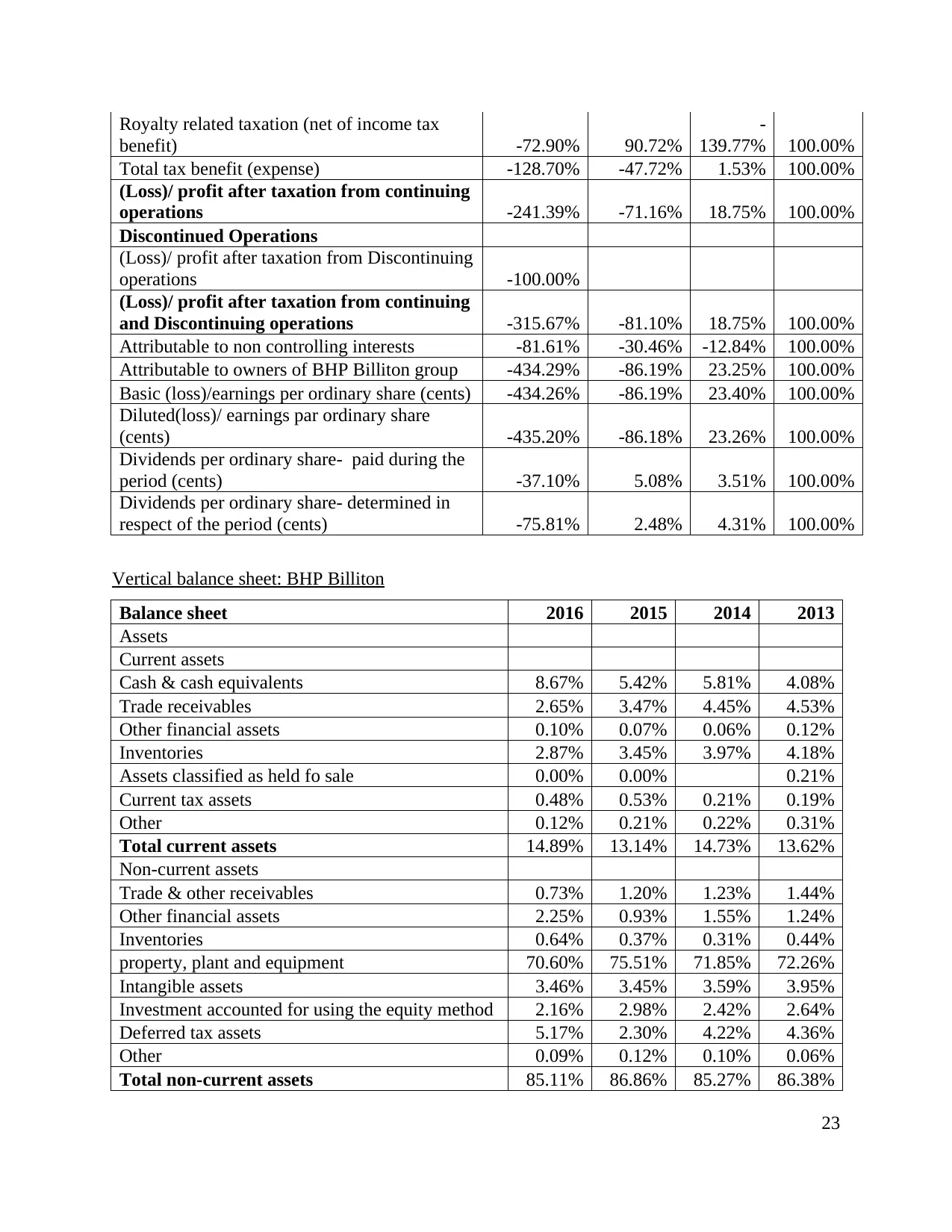
Royalty related taxation (net of income tax
benefit) -72.90% 90.72%
-
139.77% 100.00%
Total tax benefit (expense) -128.70% -47.72% 1.53% 100.00%
(Loss)/ profit after taxation from continuing
operations -241.39% -71.16% 18.75% 100.00%
Discontinued Operations
(Loss)/ profit after taxation from Discontinuing
operations -100.00%
(Loss)/ profit after taxation from continuing
and Discontinuing operations -315.67% -81.10% 18.75% 100.00%
Attributable to non controlling interests -81.61% -30.46% -12.84% 100.00%
Attributable to owners of BHP Billiton group -434.29% -86.19% 23.25% 100.00%
Basic (loss)/earnings per ordinary share (cents) -434.26% -86.19% 23.40% 100.00%
Diluted(loss)/ earnings par ordinary share
(cents) -435.20% -86.18% 23.26% 100.00%
Dividends per ordinary share- paid during the
period (cents) -37.10% 5.08% 3.51% 100.00%
Dividends per ordinary share- determined in
respect of the period (cents) -75.81% 2.48% 4.31% 100.00%
Vertical balance sheet: BHP Billiton
Balance sheet 2016 2015 2014 2013
Assets
Current assets
Cash & cash equivalents 8.67% 5.42% 5.81% 4.08%
Trade receivables 2.65% 3.47% 4.45% 4.53%
Other financial assets 0.10% 0.07% 0.06% 0.12%
Inventories 2.87% 3.45% 3.97% 4.18%
Assets classified as held fo sale 0.00% 0.00% 0.21%
Current tax assets 0.48% 0.53% 0.21% 0.19%
Other 0.12% 0.21% 0.22% 0.31%
Total current assets 14.89% 13.14% 14.73% 13.62%
Non-current assets
Trade & other receivables 0.73% 1.20% 1.23% 1.44%
Other financial assets 2.25% 0.93% 1.55% 1.24%
Inventories 0.64% 0.37% 0.31% 0.44%
property, plant and equipment 70.60% 75.51% 71.85% 72.26%
Intangible assets 3.46% 3.45% 3.59% 3.95%
Investment accounted for using the equity method 2.16% 2.98% 2.42% 2.64%
Deferred tax assets 5.17% 2.30% 4.22% 4.36%
Other 0.09% 0.12% 0.10% 0.06%
Total non-current assets 85.11% 86.86% 85.27% 86.38%
23
benefit) -72.90% 90.72%
-
139.77% 100.00%
Total tax benefit (expense) -128.70% -47.72% 1.53% 100.00%
(Loss)/ profit after taxation from continuing
operations -241.39% -71.16% 18.75% 100.00%
Discontinued Operations
(Loss)/ profit after taxation from Discontinuing
operations -100.00%
(Loss)/ profit after taxation from continuing
and Discontinuing operations -315.67% -81.10% 18.75% 100.00%
Attributable to non controlling interests -81.61% -30.46% -12.84% 100.00%
Attributable to owners of BHP Billiton group -434.29% -86.19% 23.25% 100.00%
Basic (loss)/earnings per ordinary share (cents) -434.26% -86.19% 23.40% 100.00%
Diluted(loss)/ earnings par ordinary share
(cents) -435.20% -86.18% 23.26% 100.00%
Dividends per ordinary share- paid during the
period (cents) -37.10% 5.08% 3.51% 100.00%
Dividends per ordinary share- determined in
respect of the period (cents) -75.81% 2.48% 4.31% 100.00%
Vertical balance sheet: BHP Billiton
Balance sheet 2016 2015 2014 2013
Assets
Current assets
Cash & cash equivalents 8.67% 5.42% 5.81% 4.08%
Trade receivables 2.65% 3.47% 4.45% 4.53%
Other financial assets 0.10% 0.07% 0.06% 0.12%
Inventories 2.87% 3.45% 3.97% 4.18%
Assets classified as held fo sale 0.00% 0.00% 0.21%
Current tax assets 0.48% 0.53% 0.21% 0.19%
Other 0.12% 0.21% 0.22% 0.31%
Total current assets 14.89% 13.14% 14.73% 13.62%
Non-current assets
Trade & other receivables 0.73% 1.20% 1.23% 1.44%
Other financial assets 2.25% 0.93% 1.55% 1.24%
Inventories 0.64% 0.37% 0.31% 0.44%
property, plant and equipment 70.60% 75.51% 71.85% 72.26%
Intangible assets 3.46% 3.45% 3.59% 3.95%
Investment accounted for using the equity method 2.16% 2.98% 2.42% 2.64%
Deferred tax assets 5.17% 2.30% 4.22% 4.36%
Other 0.09% 0.12% 0.10% 0.06%
Total non-current assets 85.11% 86.86% 85.27% 86.38%
23
Paraphrase This Document
Need a fresh take? Get an instant paraphrase of this document with our AI Paraphraser
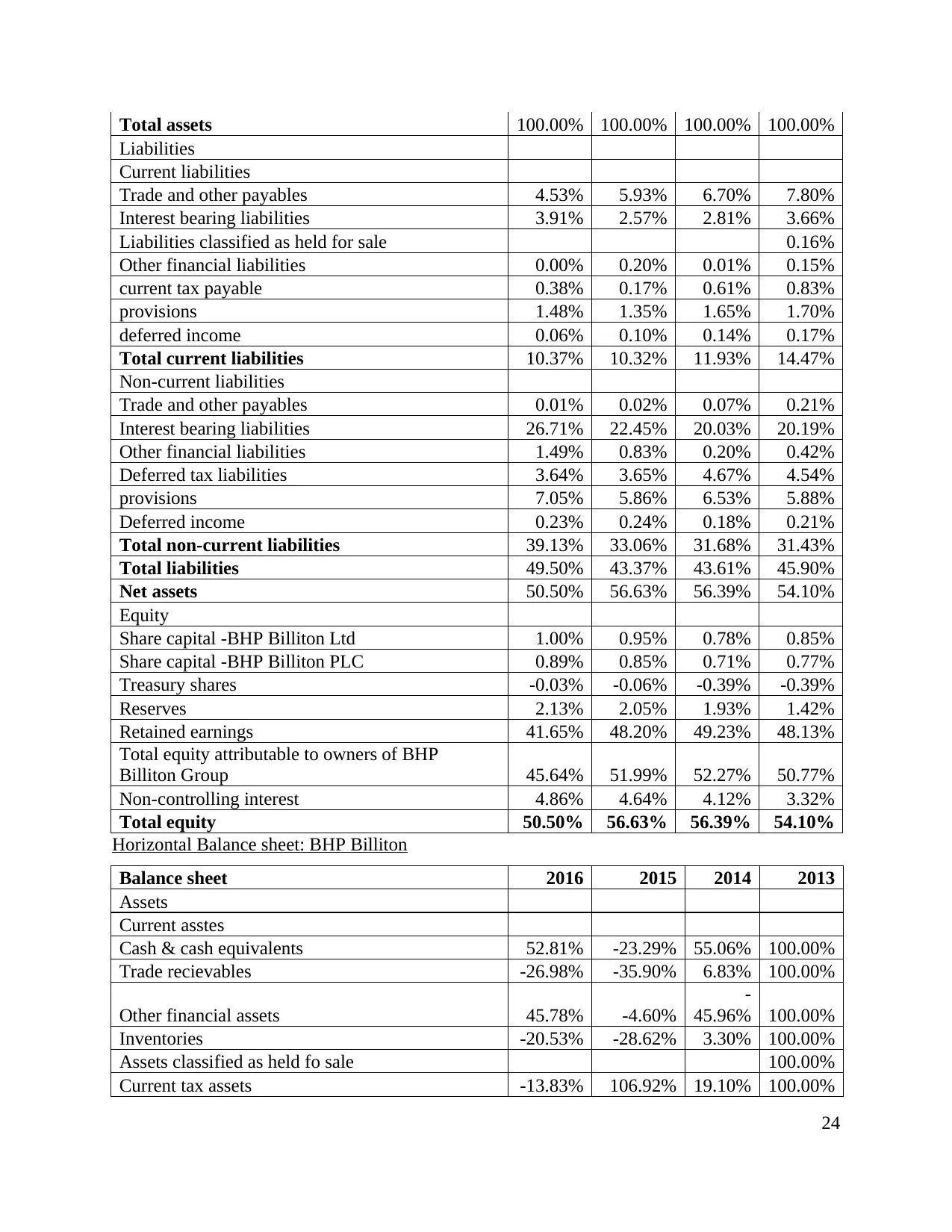
Total assets 100.00% 100.00% 100.00% 100.00%
Liabilities
Current liabilities
Trade and other payables 4.53% 5.93% 6.70% 7.80%
Interest bearing liabilities 3.91% 2.57% 2.81% 3.66%
Liabilities classified as held for sale 0.16%
Other financial liabilities 0.00% 0.20% 0.01% 0.15%
current tax payable 0.38% 0.17% 0.61% 0.83%
provisions 1.48% 1.35% 1.65% 1.70%
deferred income 0.06% 0.10% 0.14% 0.17%
Total current liabilities 10.37% 10.32% 11.93% 14.47%
Non-current liabilities
Trade and other payables 0.01% 0.02% 0.07% 0.21%
Interest bearing liabilities 26.71% 22.45% 20.03% 20.19%
Other financial liabilities 1.49% 0.83% 0.20% 0.42%
Deferred tax liabilities 3.64% 3.65% 4.67% 4.54%
provisions 7.05% 5.86% 6.53% 5.88%
Deferred income 0.23% 0.24% 0.18% 0.21%
Total non-current liabilities 39.13% 33.06% 31.68% 31.43%
Total liabilities 49.50% 43.37% 43.61% 45.90%
Net assets 50.50% 56.63% 56.39% 54.10%
Equity
Share capital -BHP Billiton Ltd 1.00% 0.95% 0.78% 0.85%
Share capital -BHP Billiton PLC 0.89% 0.85% 0.71% 0.77%
Treasury shares -0.03% -0.06% -0.39% -0.39%
Reserves 2.13% 2.05% 1.93% 1.42%
Retained earnings 41.65% 48.20% 49.23% 48.13%
Total equity attributable to owners of BHP
Billiton Group 45.64% 51.99% 52.27% 50.77%
Non-controlling interest 4.86% 4.64% 4.12% 3.32%
Total equity 50.50% 56.63% 56.39% 54.10%
Horizontal Balance sheet: BHP Billiton
Balance sheet 2016 2015 2014 2013
Assets
Current asstes
Cash & cash equivalents 52.81% -23.29% 55.06% 100.00%
Trade recievables -26.98% -35.90% 6.83% 100.00%
Other financial assets 45.78% -4.60%
-
45.96% 100.00%
Inventories -20.53% -28.62% 3.30% 100.00%
Assets classified as held fo sale 100.00%
Current tax assets -13.83% 106.92% 19.10% 100.00%
24
Liabilities
Current liabilities
Trade and other payables 4.53% 5.93% 6.70% 7.80%
Interest bearing liabilities 3.91% 2.57% 2.81% 3.66%
Liabilities classified as held for sale 0.16%
Other financial liabilities 0.00% 0.20% 0.01% 0.15%
current tax payable 0.38% 0.17% 0.61% 0.83%
provisions 1.48% 1.35% 1.65% 1.70%
deferred income 0.06% 0.10% 0.14% 0.17%
Total current liabilities 10.37% 10.32% 11.93% 14.47%
Non-current liabilities
Trade and other payables 0.01% 0.02% 0.07% 0.21%
Interest bearing liabilities 26.71% 22.45% 20.03% 20.19%
Other financial liabilities 1.49% 0.83% 0.20% 0.42%
Deferred tax liabilities 3.64% 3.65% 4.67% 4.54%
provisions 7.05% 5.86% 6.53% 5.88%
Deferred income 0.23% 0.24% 0.18% 0.21%
Total non-current liabilities 39.13% 33.06% 31.68% 31.43%
Total liabilities 49.50% 43.37% 43.61% 45.90%
Net assets 50.50% 56.63% 56.39% 54.10%
Equity
Share capital -BHP Billiton Ltd 1.00% 0.95% 0.78% 0.85%
Share capital -BHP Billiton PLC 0.89% 0.85% 0.71% 0.77%
Treasury shares -0.03% -0.06% -0.39% -0.39%
Reserves 2.13% 2.05% 1.93% 1.42%
Retained earnings 41.65% 48.20% 49.23% 48.13%
Total equity attributable to owners of BHP
Billiton Group 45.64% 51.99% 52.27% 50.77%
Non-controlling interest 4.86% 4.64% 4.12% 3.32%
Total equity 50.50% 56.63% 56.39% 54.10%
Horizontal Balance sheet: BHP Billiton
Balance sheet 2016 2015 2014 2013
Assets
Current asstes
Cash & cash equivalents 52.81% -23.29% 55.06% 100.00%
Trade recievables -26.98% -35.90% 6.83% 100.00%
Other financial assets 45.78% -4.60%
-
45.96% 100.00%
Inventories -20.53% -28.62% 3.30% 100.00%
Assets classified as held fo sale 100.00%
Current tax assets -13.83% 106.92% 19.10% 100.00%
24
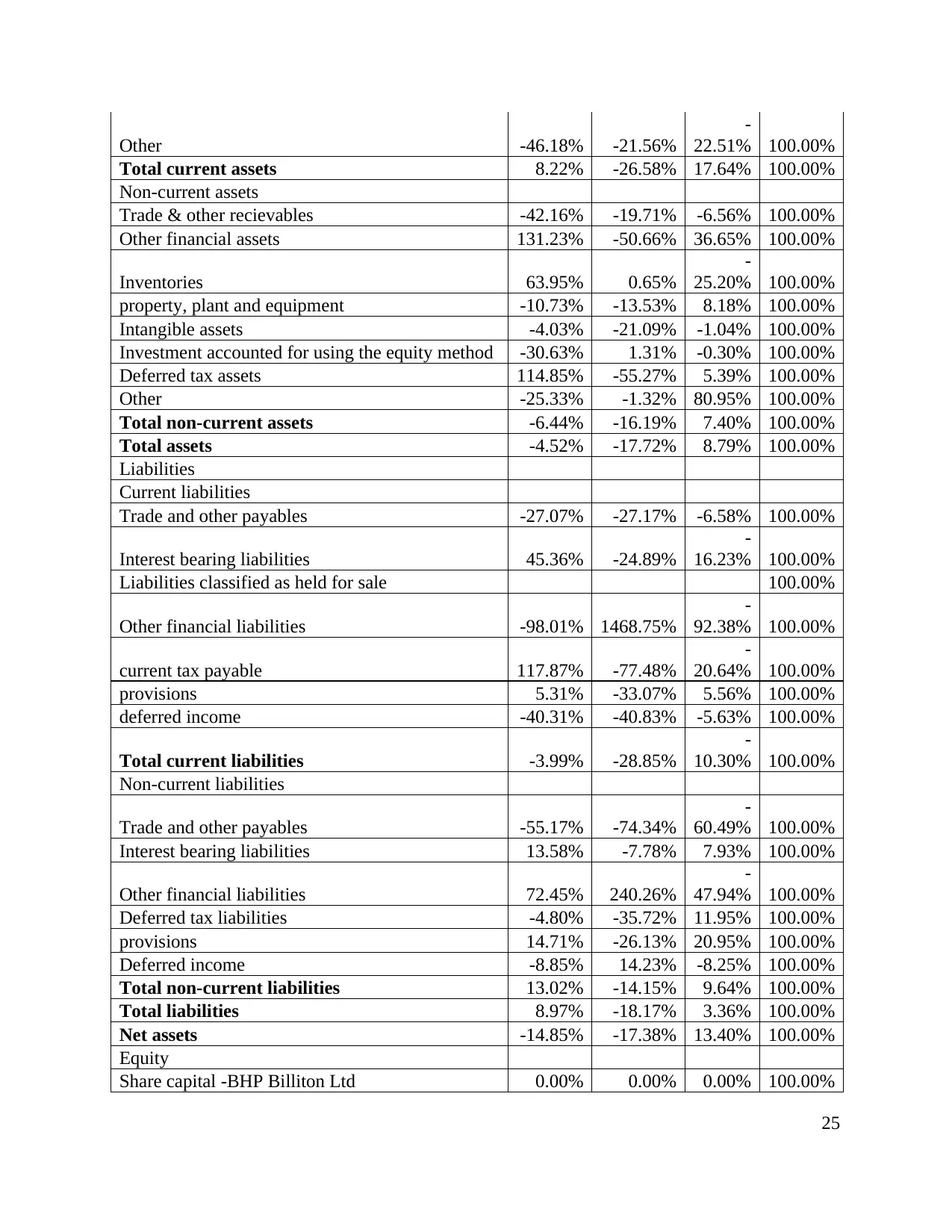
Other -46.18% -21.56%
-
22.51% 100.00%
Total current assets 8.22% -26.58% 17.64% 100.00%
Non-current assets
Trade & other recievables -42.16% -19.71% -6.56% 100.00%
Other financial assets 131.23% -50.66% 36.65% 100.00%
Inventories 63.95% 0.65%
-
25.20% 100.00%
property, plant and equipment -10.73% -13.53% 8.18% 100.00%
Intangible assets -4.03% -21.09% -1.04% 100.00%
Investment accounted for using the equity method -30.63% 1.31% -0.30% 100.00%
Deferred tax assets 114.85% -55.27% 5.39% 100.00%
Other -25.33% -1.32% 80.95% 100.00%
Total non-current assets -6.44% -16.19% 7.40% 100.00%
Total assets -4.52% -17.72% 8.79% 100.00%
Liabilities
Current liabilities
Trade and other payables -27.07% -27.17% -6.58% 100.00%
Interest bearing liabilities 45.36% -24.89%
-
16.23% 100.00%
Liabilities classified as held for sale 100.00%
Other financial liabilities -98.01% 1468.75%
-
92.38% 100.00%
current tax payable 117.87% -77.48%
-
20.64% 100.00%
provisions 5.31% -33.07% 5.56% 100.00%
deferred income -40.31% -40.83% -5.63% 100.00%
Total current liabilities -3.99% -28.85%
-
10.30% 100.00%
Non-current liabilities
Trade and other payables -55.17% -74.34%
-
60.49% 100.00%
Interest bearing liabilities 13.58% -7.78% 7.93% 100.00%
Other financial liabilities 72.45% 240.26%
-
47.94% 100.00%
Deferred tax liabilities -4.80% -35.72% 11.95% 100.00%
provisions 14.71% -26.13% 20.95% 100.00%
Deferred income -8.85% 14.23% -8.25% 100.00%
Total non-current liabilities 13.02% -14.15% 9.64% 100.00%
Total liabilities 8.97% -18.17% 3.36% 100.00%
Net assets -14.85% -17.38% 13.40% 100.00%
Equity
Share capital -BHP Billiton Ltd 0.00% 0.00% 0.00% 100.00%
25
-
22.51% 100.00%
Total current assets 8.22% -26.58% 17.64% 100.00%
Non-current assets
Trade & other recievables -42.16% -19.71% -6.56% 100.00%
Other financial assets 131.23% -50.66% 36.65% 100.00%
Inventories 63.95% 0.65%
-
25.20% 100.00%
property, plant and equipment -10.73% -13.53% 8.18% 100.00%
Intangible assets -4.03% -21.09% -1.04% 100.00%
Investment accounted for using the equity method -30.63% 1.31% -0.30% 100.00%
Deferred tax assets 114.85% -55.27% 5.39% 100.00%
Other -25.33% -1.32% 80.95% 100.00%
Total non-current assets -6.44% -16.19% 7.40% 100.00%
Total assets -4.52% -17.72% 8.79% 100.00%
Liabilities
Current liabilities
Trade and other payables -27.07% -27.17% -6.58% 100.00%
Interest bearing liabilities 45.36% -24.89%
-
16.23% 100.00%
Liabilities classified as held for sale 100.00%
Other financial liabilities -98.01% 1468.75%
-
92.38% 100.00%
current tax payable 117.87% -77.48%
-
20.64% 100.00%
provisions 5.31% -33.07% 5.56% 100.00%
deferred income -40.31% -40.83% -5.63% 100.00%
Total current liabilities -3.99% -28.85%
-
10.30% 100.00%
Non-current liabilities
Trade and other payables -55.17% -74.34%
-
60.49% 100.00%
Interest bearing liabilities 13.58% -7.78% 7.93% 100.00%
Other financial liabilities 72.45% 240.26%
-
47.94% 100.00%
Deferred tax liabilities -4.80% -35.72% 11.95% 100.00%
provisions 14.71% -26.13% 20.95% 100.00%
Deferred income -8.85% 14.23% -8.25% 100.00%
Total non-current liabilities 13.02% -14.15% 9.64% 100.00%
Total liabilities 8.97% -18.17% 3.36% 100.00%
Net assets -14.85% -17.38% 13.40% 100.00%
Equity
Share capital -BHP Billiton Ltd 0.00% 0.00% 0.00% 100.00%
25
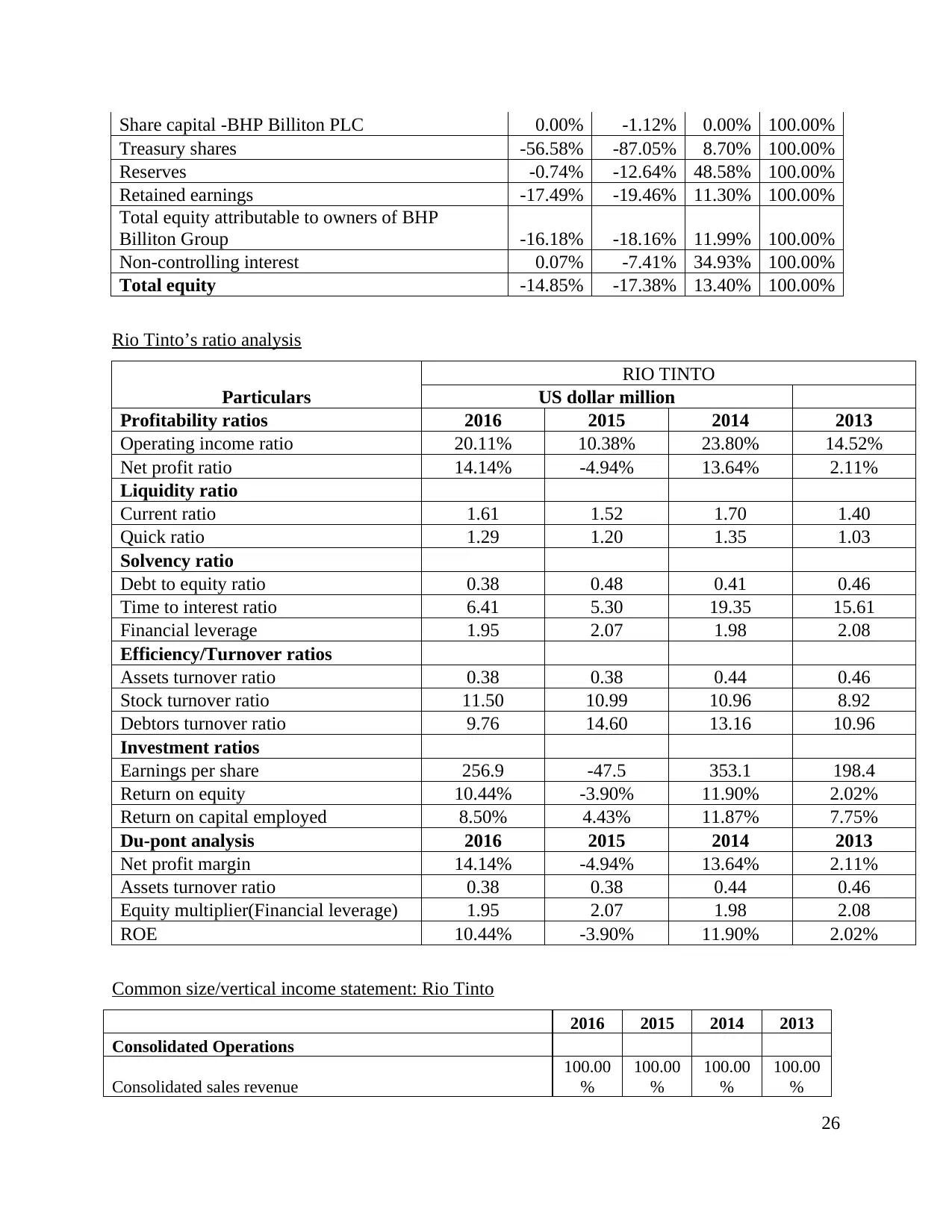
Share capital -BHP Billiton PLC 0.00% -1.12% 0.00% 100.00%
Treasury shares -56.58% -87.05% 8.70% 100.00%
Reserves -0.74% -12.64% 48.58% 100.00%
Retained earnings -17.49% -19.46% 11.30% 100.00%
Total equity attributable to owners of BHP
Billiton Group -16.18% -18.16% 11.99% 100.00%
Non-controlling interest 0.07% -7.41% 34.93% 100.00%
Total equity -14.85% -17.38% 13.40% 100.00%
Rio Tinto’s ratio analysis
Particulars
RIO TINTO
US dollar million
Profitability ratios 2016 2015 2014 2013
Operating income ratio 20.11% 10.38% 23.80% 14.52%
Net profit ratio 14.14% -4.94% 13.64% 2.11%
Liquidity ratio
Current ratio 1.61 1.52 1.70 1.40
Quick ratio 1.29 1.20 1.35 1.03
Solvency ratio
Debt to equity ratio 0.38 0.48 0.41 0.46
Time to interest ratio 6.41 5.30 19.35 15.61
Financial leverage 1.95 2.07 1.98 2.08
Efficiency/Turnover ratios
Assets turnover ratio 0.38 0.38 0.44 0.46
Stock turnover ratio 11.50 10.99 10.96 8.92
Debtors turnover ratio 9.76 14.60 13.16 10.96
Investment ratios
Earnings per share 256.9 -47.5 353.1 198.4
Return on equity 10.44% -3.90% 11.90% 2.02%
Return on capital employed 8.50% 4.43% 11.87% 7.75%
Du-pont analysis 2016 2015 2014 2013
Net profit margin 14.14% -4.94% 13.64% 2.11%
Assets turnover ratio 0.38 0.38 0.44 0.46
Equity multiplier(Financial leverage) 1.95 2.07 1.98 2.08
ROE 10.44% -3.90% 11.90% 2.02%
Common size/vertical income statement: Rio Tinto
2016 2015 2014 2013
Consolidated Operations
Consolidated sales revenue
100.00
%
100.00
%
100.00
%
100.00
%
26
Treasury shares -56.58% -87.05% 8.70% 100.00%
Reserves -0.74% -12.64% 48.58% 100.00%
Retained earnings -17.49% -19.46% 11.30% 100.00%
Total equity attributable to owners of BHP
Billiton Group -16.18% -18.16% 11.99% 100.00%
Non-controlling interest 0.07% -7.41% 34.93% 100.00%
Total equity -14.85% -17.38% 13.40% 100.00%
Rio Tinto’s ratio analysis
Particulars
RIO TINTO
US dollar million
Profitability ratios 2016 2015 2014 2013
Operating income ratio 20.11% 10.38% 23.80% 14.52%
Net profit ratio 14.14% -4.94% 13.64% 2.11%
Liquidity ratio
Current ratio 1.61 1.52 1.70 1.40
Quick ratio 1.29 1.20 1.35 1.03
Solvency ratio
Debt to equity ratio 0.38 0.48 0.41 0.46
Time to interest ratio 6.41 5.30 19.35 15.61
Financial leverage 1.95 2.07 1.98 2.08
Efficiency/Turnover ratios
Assets turnover ratio 0.38 0.38 0.44 0.46
Stock turnover ratio 11.50 10.99 10.96 8.92
Debtors turnover ratio 9.76 14.60 13.16 10.96
Investment ratios
Earnings per share 256.9 -47.5 353.1 198.4
Return on equity 10.44% -3.90% 11.90% 2.02%
Return on capital employed 8.50% 4.43% 11.87% 7.75%
Du-pont analysis 2016 2015 2014 2013
Net profit margin 14.14% -4.94% 13.64% 2.11%
Assets turnover ratio 0.38 0.38 0.44 0.46
Equity multiplier(Financial leverage) 1.95 2.07 1.98 2.08
ROE 10.44% -3.90% 11.90% 2.02%
Common size/vertical income statement: Rio Tinto
2016 2015 2014 2013
Consolidated Operations
Consolidated sales revenue
100.00
%
100.00
%
100.00
%
100.00
%
26
Secure Best Marks with AI Grader
Need help grading? Try our AI Grader for instant feedback on your assignments.
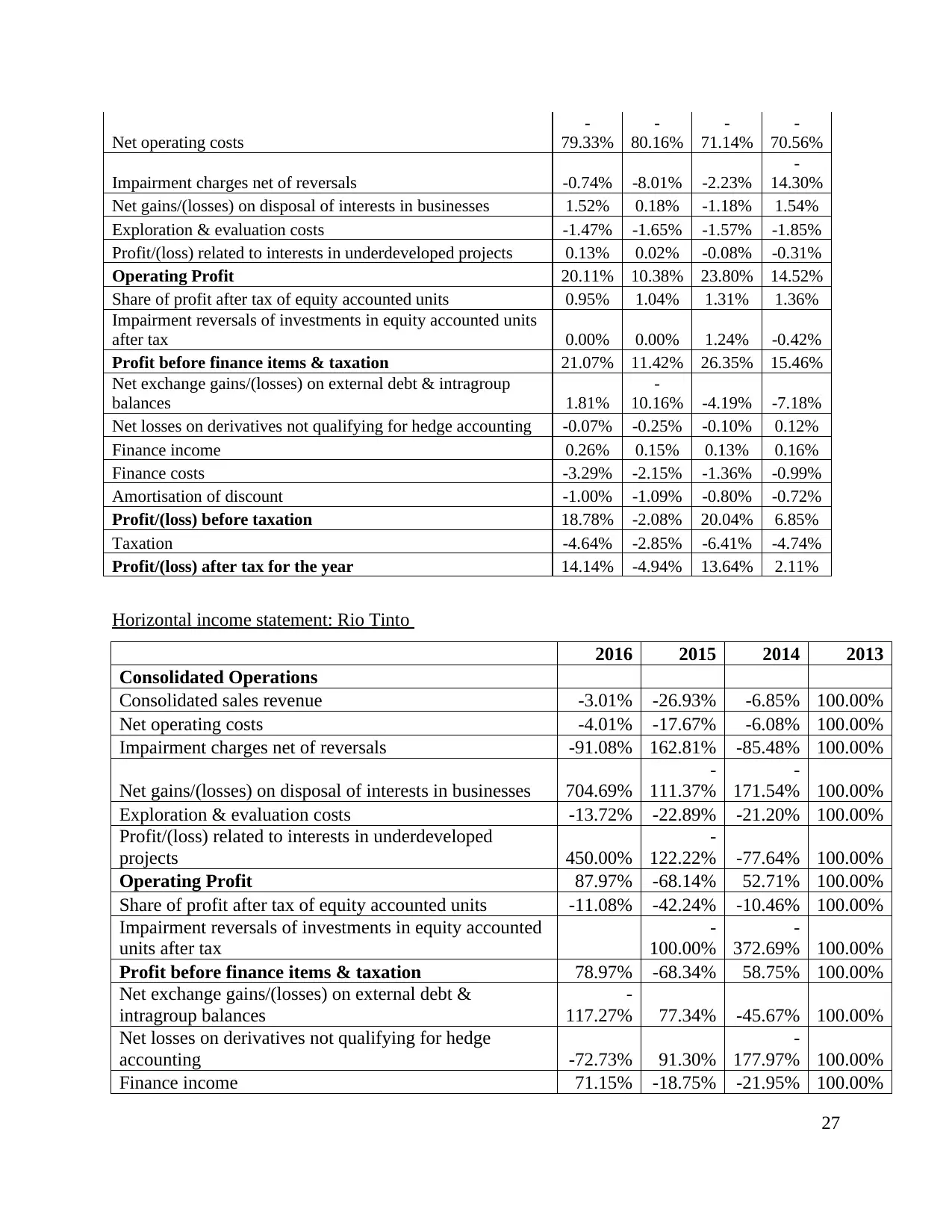
Net operating costs
-
79.33%
-
80.16%
-
71.14%
-
70.56%
Impairment charges net of reversals -0.74% -8.01% -2.23%
-
14.30%
Net gains/(losses) on disposal of interests in businesses 1.52% 0.18% -1.18% 1.54%
Exploration & evaluation costs -1.47% -1.65% -1.57% -1.85%
Profit/(loss) related to interests in underdeveloped projects 0.13% 0.02% -0.08% -0.31%
Operating Profit 20.11% 10.38% 23.80% 14.52%
Share of profit after tax of equity accounted units 0.95% 1.04% 1.31% 1.36%
Impairment reversals of investments in equity accounted units
after tax 0.00% 0.00% 1.24% -0.42%
Profit before finance items & taxation 21.07% 11.42% 26.35% 15.46%
Net exchange gains/(losses) on external debt & intragroup
balances 1.81%
-
10.16% -4.19% -7.18%
Net losses on derivatives not qualifying for hedge accounting -0.07% -0.25% -0.10% 0.12%
Finance income 0.26% 0.15% 0.13% 0.16%
Finance costs -3.29% -2.15% -1.36% -0.99%
Amortisation of discount -1.00% -1.09% -0.80% -0.72%
Profit/(loss) before taxation 18.78% -2.08% 20.04% 6.85%
Taxation -4.64% -2.85% -6.41% -4.74%
Profit/(loss) after tax for the year 14.14% -4.94% 13.64% 2.11%
Horizontal income statement: Rio Tinto
2016 2015 2014 2013
Consolidated Operations
Consolidated sales revenue -3.01% -26.93% -6.85% 100.00%
Net operating costs -4.01% -17.67% -6.08% 100.00%
Impairment charges net of reversals -91.08% 162.81% -85.48% 100.00%
Net gains/(losses) on disposal of interests in businesses 704.69%
-
111.37%
-
171.54% 100.00%
Exploration & evaluation costs -13.72% -22.89% -21.20% 100.00%
Profit/(loss) related to interests in underdeveloped
projects 450.00%
-
122.22% -77.64% 100.00%
Operating Profit 87.97% -68.14% 52.71% 100.00%
Share of profit after tax of equity accounted units -11.08% -42.24% -10.46% 100.00%
Impairment reversals of investments in equity accounted
units after tax
-
100.00%
-
372.69% 100.00%
Profit before finance items & taxation 78.97% -68.34% 58.75% 100.00%
Net exchange gains/(losses) on external debt &
intragroup balances
-
117.27% 77.34% -45.67% 100.00%
Net losses on derivatives not qualifying for hedge
accounting -72.73% 91.30%
-
177.97% 100.00%
Finance income 71.15% -18.75% -21.95% 100.00%
27
-
79.33%
-
80.16%
-
71.14%
-
70.56%
Impairment charges net of reversals -0.74% -8.01% -2.23%
-
14.30%
Net gains/(losses) on disposal of interests in businesses 1.52% 0.18% -1.18% 1.54%
Exploration & evaluation costs -1.47% -1.65% -1.57% -1.85%
Profit/(loss) related to interests in underdeveloped projects 0.13% 0.02% -0.08% -0.31%
Operating Profit 20.11% 10.38% 23.80% 14.52%
Share of profit after tax of equity accounted units 0.95% 1.04% 1.31% 1.36%
Impairment reversals of investments in equity accounted units
after tax 0.00% 0.00% 1.24% -0.42%
Profit before finance items & taxation 21.07% 11.42% 26.35% 15.46%
Net exchange gains/(losses) on external debt & intragroup
balances 1.81%
-
10.16% -4.19% -7.18%
Net losses on derivatives not qualifying for hedge accounting -0.07% -0.25% -0.10% 0.12%
Finance income 0.26% 0.15% 0.13% 0.16%
Finance costs -3.29% -2.15% -1.36% -0.99%
Amortisation of discount -1.00% -1.09% -0.80% -0.72%
Profit/(loss) before taxation 18.78% -2.08% 20.04% 6.85%
Taxation -4.64% -2.85% -6.41% -4.74%
Profit/(loss) after tax for the year 14.14% -4.94% 13.64% 2.11%
Horizontal income statement: Rio Tinto
2016 2015 2014 2013
Consolidated Operations
Consolidated sales revenue -3.01% -26.93% -6.85% 100.00%
Net operating costs -4.01% -17.67% -6.08% 100.00%
Impairment charges net of reversals -91.08% 162.81% -85.48% 100.00%
Net gains/(losses) on disposal of interests in businesses 704.69%
-
111.37%
-
171.54% 100.00%
Exploration & evaluation costs -13.72% -22.89% -21.20% 100.00%
Profit/(loss) related to interests in underdeveloped
projects 450.00%
-
122.22% -77.64% 100.00%
Operating Profit 87.97% -68.14% 52.71% 100.00%
Share of profit after tax of equity accounted units -11.08% -42.24% -10.46% 100.00%
Impairment reversals of investments in equity accounted
units after tax
-
100.00%
-
372.69% 100.00%
Profit before finance items & taxation 78.97% -68.34% 58.75% 100.00%
Net exchange gains/(losses) on external debt &
intragroup balances
-
117.27% 77.34% -45.67% 100.00%
Net losses on derivatives not qualifying for hedge
accounting -72.73% 91.30%
-
177.97% 100.00%
Finance income 71.15% -18.75% -21.95% 100.00%
27
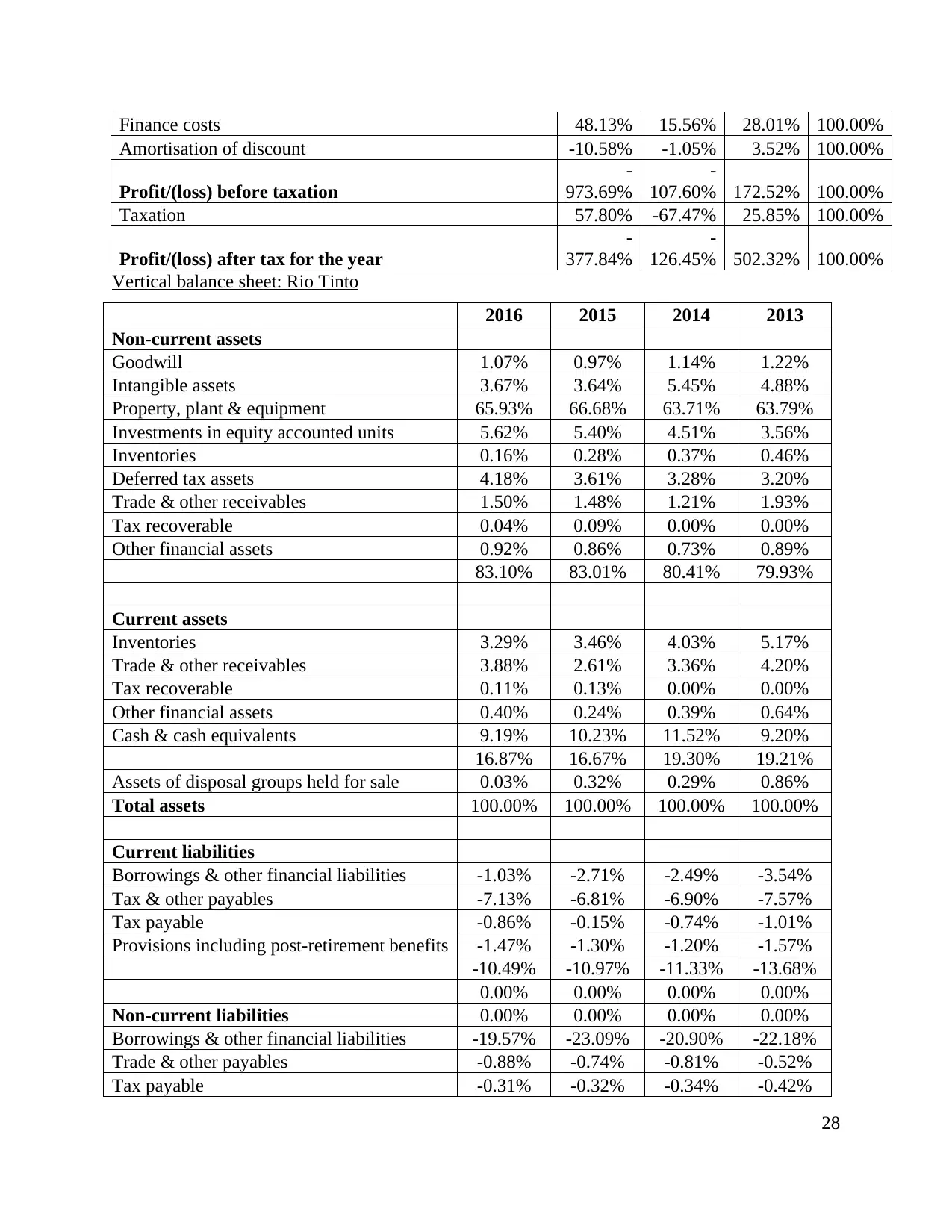
Finance costs 48.13% 15.56% 28.01% 100.00%
Amortisation of discount -10.58% -1.05% 3.52% 100.00%
Profit/(loss) before taxation
-
973.69%
-
107.60% 172.52% 100.00%
Taxation 57.80% -67.47% 25.85% 100.00%
Profit/(loss) after tax for the year
-
377.84%
-
126.45% 502.32% 100.00%
Vertical balance sheet: Rio Tinto
2016 2015 2014 2013
Non-current assets
Goodwill 1.07% 0.97% 1.14% 1.22%
Intangible assets 3.67% 3.64% 5.45% 4.88%
Property, plant & equipment 65.93% 66.68% 63.71% 63.79%
Investments in equity accounted units 5.62% 5.40% 4.51% 3.56%
Inventories 0.16% 0.28% 0.37% 0.46%
Deferred tax assets 4.18% 3.61% 3.28% 3.20%
Trade & other receivables 1.50% 1.48% 1.21% 1.93%
Tax recoverable 0.04% 0.09% 0.00% 0.00%
Other financial assets 0.92% 0.86% 0.73% 0.89%
83.10% 83.01% 80.41% 79.93%
Current assets
Inventories 3.29% 3.46% 4.03% 5.17%
Trade & other receivables 3.88% 2.61% 3.36% 4.20%
Tax recoverable 0.11% 0.13% 0.00% 0.00%
Other financial assets 0.40% 0.24% 0.39% 0.64%
Cash & cash equivalents 9.19% 10.23% 11.52% 9.20%
16.87% 16.67% 19.30% 19.21%
Assets of disposal groups held for sale 0.03% 0.32% 0.29% 0.86%
Total assets 100.00% 100.00% 100.00% 100.00%
Current liabilities
Borrowings & other financial liabilities -1.03% -2.71% -2.49% -3.54%
Tax & other payables -7.13% -6.81% -6.90% -7.57%
Tax payable -0.86% -0.15% -0.74% -1.01%
Provisions including post-retirement benefits -1.47% -1.30% -1.20% -1.57%
-10.49% -10.97% -11.33% -13.68%
0.00% 0.00% 0.00% 0.00%
Non-current liabilities 0.00% 0.00% 0.00% 0.00%
Borrowings & other financial liabilities -19.57% -23.09% -20.90% -22.18%
Trade & other payables -0.88% -0.74% -0.81% -0.52%
Tax payable -0.31% -0.32% -0.34% -0.42%
28
Amortisation of discount -10.58% -1.05% 3.52% 100.00%
Profit/(loss) before taxation
-
973.69%
-
107.60% 172.52% 100.00%
Taxation 57.80% -67.47% 25.85% 100.00%
Profit/(loss) after tax for the year
-
377.84%
-
126.45% 502.32% 100.00%
Vertical balance sheet: Rio Tinto
2016 2015 2014 2013
Non-current assets
Goodwill 1.07% 0.97% 1.14% 1.22%
Intangible assets 3.67% 3.64% 5.45% 4.88%
Property, plant & equipment 65.93% 66.68% 63.71% 63.79%
Investments in equity accounted units 5.62% 5.40% 4.51% 3.56%
Inventories 0.16% 0.28% 0.37% 0.46%
Deferred tax assets 4.18% 3.61% 3.28% 3.20%
Trade & other receivables 1.50% 1.48% 1.21% 1.93%
Tax recoverable 0.04% 0.09% 0.00% 0.00%
Other financial assets 0.92% 0.86% 0.73% 0.89%
83.10% 83.01% 80.41% 79.93%
Current assets
Inventories 3.29% 3.46% 4.03% 5.17%
Trade & other receivables 3.88% 2.61% 3.36% 4.20%
Tax recoverable 0.11% 0.13% 0.00% 0.00%
Other financial assets 0.40% 0.24% 0.39% 0.64%
Cash & cash equivalents 9.19% 10.23% 11.52% 9.20%
16.87% 16.67% 19.30% 19.21%
Assets of disposal groups held for sale 0.03% 0.32% 0.29% 0.86%
Total assets 100.00% 100.00% 100.00% 100.00%
Current liabilities
Borrowings & other financial liabilities -1.03% -2.71% -2.49% -3.54%
Tax & other payables -7.13% -6.81% -6.90% -7.57%
Tax payable -0.86% -0.15% -0.74% -1.01%
Provisions including post-retirement benefits -1.47% -1.30% -1.20% -1.57%
-10.49% -10.97% -11.33% -13.68%
0.00% 0.00% 0.00% 0.00%
Non-current liabilities 0.00% 0.00% 0.00% 0.00%
Borrowings & other financial liabilities -19.57% -23.09% -20.90% -22.18%
Trade & other payables -0.88% -0.74% -0.81% -0.52%
Tax payable -0.31% -0.32% -0.34% -0.42%
28
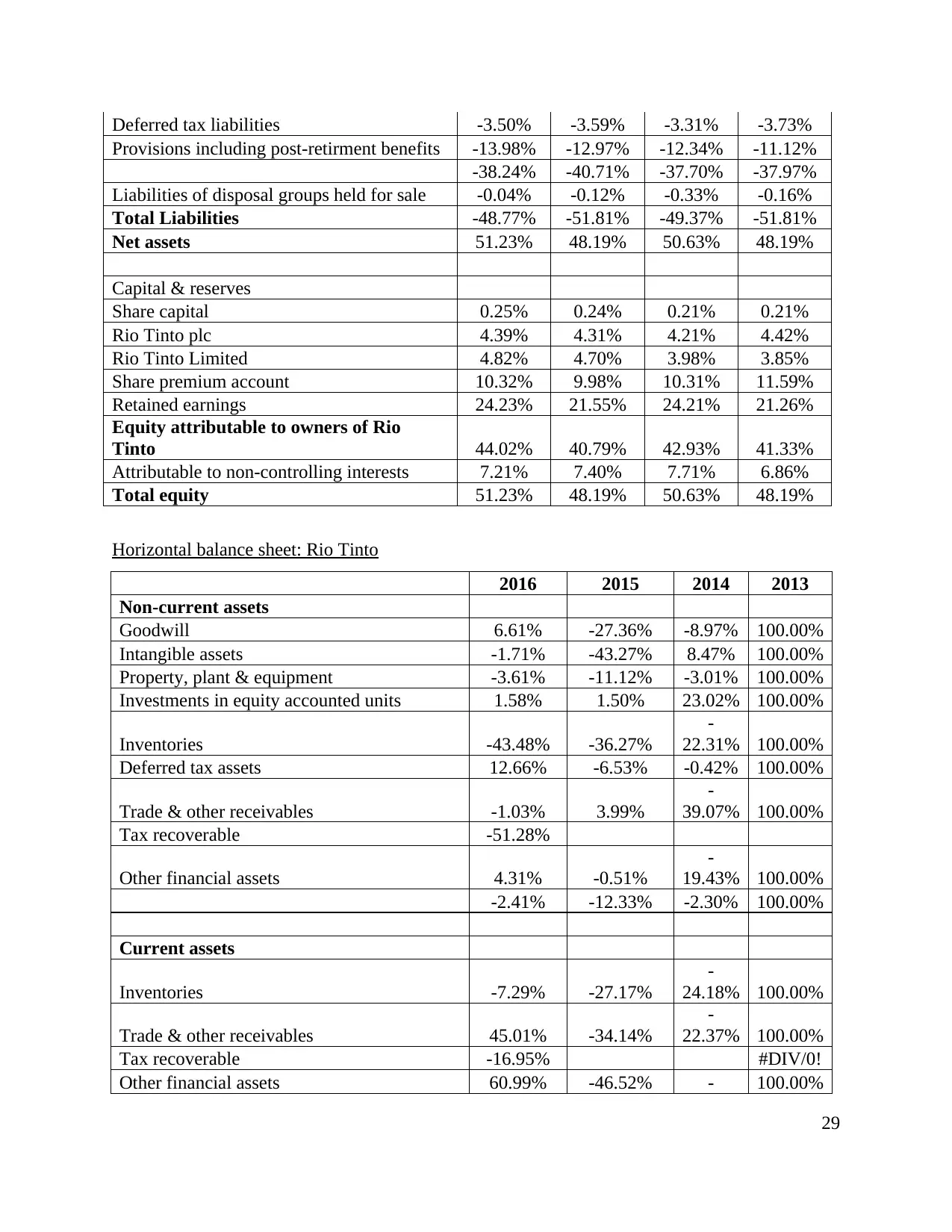
Deferred tax liabilities -3.50% -3.59% -3.31% -3.73%
Provisions including post-retirment benefits -13.98% -12.97% -12.34% -11.12%
-38.24% -40.71% -37.70% -37.97%
Liabilities of disposal groups held for sale -0.04% -0.12% -0.33% -0.16%
Total Liabilities -48.77% -51.81% -49.37% -51.81%
Net assets 51.23% 48.19% 50.63% 48.19%
Capital & reserves
Share capital 0.25% 0.24% 0.21% 0.21%
Rio Tinto plc 4.39% 4.31% 4.21% 4.42%
Rio Tinto Limited 4.82% 4.70% 3.98% 3.85%
Share premium account 10.32% 9.98% 10.31% 11.59%
Retained earnings 24.23% 21.55% 24.21% 21.26%
Equity attributable to owners of Rio
Tinto 44.02% 40.79% 42.93% 41.33%
Attributable to non-controlling interests 7.21% 7.40% 7.71% 6.86%
Total equity 51.23% 48.19% 50.63% 48.19%
Horizontal balance sheet: Rio Tinto
2016 2015 2014 2013
Non-current assets
Goodwill 6.61% -27.36% -8.97% 100.00%
Intangible assets -1.71% -43.27% 8.47% 100.00%
Property, plant & equipment -3.61% -11.12% -3.01% 100.00%
Investments in equity accounted units 1.58% 1.50% 23.02% 100.00%
Inventories -43.48% -36.27%
-
22.31% 100.00%
Deferred tax assets 12.66% -6.53% -0.42% 100.00%
Trade & other receivables -1.03% 3.99%
-
39.07% 100.00%
Tax recoverable -51.28%
Other financial assets 4.31% -0.51%
-
19.43% 100.00%
-2.41% -12.33% -2.30% 100.00%
Current assets
Inventories -7.29% -27.17%
-
24.18% 100.00%
Trade & other receivables 45.01% -34.14%
-
22.37% 100.00%
Tax recoverable -16.95% #DIV/0!
Other financial assets 60.99% -46.52% - 100.00%
29
Provisions including post-retirment benefits -13.98% -12.97% -12.34% -11.12%
-38.24% -40.71% -37.70% -37.97%
Liabilities of disposal groups held for sale -0.04% -0.12% -0.33% -0.16%
Total Liabilities -48.77% -51.81% -49.37% -51.81%
Net assets 51.23% 48.19% 50.63% 48.19%
Capital & reserves
Share capital 0.25% 0.24% 0.21% 0.21%
Rio Tinto plc 4.39% 4.31% 4.21% 4.42%
Rio Tinto Limited 4.82% 4.70% 3.98% 3.85%
Share premium account 10.32% 9.98% 10.31% 11.59%
Retained earnings 24.23% 21.55% 24.21% 21.26%
Equity attributable to owners of Rio
Tinto 44.02% 40.79% 42.93% 41.33%
Attributable to non-controlling interests 7.21% 7.40% 7.71% 6.86%
Total equity 51.23% 48.19% 50.63% 48.19%
Horizontal balance sheet: Rio Tinto
2016 2015 2014 2013
Non-current assets
Goodwill 6.61% -27.36% -8.97% 100.00%
Intangible assets -1.71% -43.27% 8.47% 100.00%
Property, plant & equipment -3.61% -11.12% -3.01% 100.00%
Investments in equity accounted units 1.58% 1.50% 23.02% 100.00%
Inventories -43.48% -36.27%
-
22.31% 100.00%
Deferred tax assets 12.66% -6.53% -0.42% 100.00%
Trade & other receivables -1.03% 3.99%
-
39.07% 100.00%
Tax recoverable -51.28%
Other financial assets 4.31% -0.51%
-
19.43% 100.00%
-2.41% -12.33% -2.30% 100.00%
Current assets
Inventories -7.29% -27.17%
-
24.18% 100.00%
Trade & other receivables 45.01% -34.14%
-
22.37% 100.00%
Tax recoverable -16.95% #DIV/0!
Other financial assets 60.99% -46.52% - 100.00%
29
Paraphrase This Document
Need a fresh take? Get an instant paraphrase of this document with our AI Paraphraser

41.27%
Cash & cash equivalents -12.44% -24.61% 21.60% 100.00%
-1.35% -26.68% -2.42% 100.00%
Assets of disposal groups held for sale -89.42% -6.09%
-
67.23% 100.00%
Total assets -2.51% -15.08% -2.88% 100.00%
Current liabilities
Borrowings & other financial liabilities -62.88% -7.45%
-
31.64% 100.00%
Tax & other payables 1.99% -16.14%
-
11.46% 100.00%
Tax payable 465.93% -83.13%
-
28.95% 100.00%
Provisions including post-retirement benefits 10.50% -8.39%
-
25.26% 100.00%
-6.81% -17.79%
-
19.55% 100.00%
Non-current liabilities
Borrowings & other financial liabilities -17.36% -6.19% -8.49% 100.00%
Trade & other payables 15.69% -21.70% 51.22% 100.00%
Tax payable -7.12% -20.27%
-
20.94% 100.00%
Deferred tax liabilities -5.02% -8.06%
-
13.67% 100.00%
Provisions including post-retirment benefits 5.08% -10.73% 7.78% 100.00%
-8.44% -8.30% -3.56% 100.00%
Liabilities of disposal groups held for sale -65.77% -69.17% 98.90% 100.00%
Total Liabilities -8.23% -10.89% -7.46% 100.00%
Net assets 3.63% -19.17% 2.04% 100.00%
Capital & reserves
Share capital 0.00% -2.61% 0.00% 100.00%
Rio Tinto plc -0.89% -12.90% -7.66% 100.00%
` 0.09% 0.28% 0.45% 100.00%
Share premium account 0.84% -17.83%
-
13.59% 100.00%
Retained earnings 9.60% -24.41% 10.61% 100.00%
Equity attributable to owners of Rio Tinto 5.20% -19.31% 0.87% 100.00%
Attributable to non-controlling interests -5.00% -18.41% 9.10% 100.00%
Total equity 3.63% -19.17% 2.04% 100.00%
30
Cash & cash equivalents -12.44% -24.61% 21.60% 100.00%
-1.35% -26.68% -2.42% 100.00%
Assets of disposal groups held for sale -89.42% -6.09%
-
67.23% 100.00%
Total assets -2.51% -15.08% -2.88% 100.00%
Current liabilities
Borrowings & other financial liabilities -62.88% -7.45%
-
31.64% 100.00%
Tax & other payables 1.99% -16.14%
-
11.46% 100.00%
Tax payable 465.93% -83.13%
-
28.95% 100.00%
Provisions including post-retirement benefits 10.50% -8.39%
-
25.26% 100.00%
-6.81% -17.79%
-
19.55% 100.00%
Non-current liabilities
Borrowings & other financial liabilities -17.36% -6.19% -8.49% 100.00%
Trade & other payables 15.69% -21.70% 51.22% 100.00%
Tax payable -7.12% -20.27%
-
20.94% 100.00%
Deferred tax liabilities -5.02% -8.06%
-
13.67% 100.00%
Provisions including post-retirment benefits 5.08% -10.73% 7.78% 100.00%
-8.44% -8.30% -3.56% 100.00%
Liabilities of disposal groups held for sale -65.77% -69.17% 98.90% 100.00%
Total Liabilities -8.23% -10.89% -7.46% 100.00%
Net assets 3.63% -19.17% 2.04% 100.00%
Capital & reserves
Share capital 0.00% -2.61% 0.00% 100.00%
Rio Tinto plc -0.89% -12.90% -7.66% 100.00%
` 0.09% 0.28% 0.45% 100.00%
Share premium account 0.84% -17.83%
-
13.59% 100.00%
Retained earnings 9.60% -24.41% 10.61% 100.00%
Equity attributable to owners of Rio Tinto 5.20% -19.31% 0.87% 100.00%
Attributable to non-controlling interests -5.00% -18.41% 9.10% 100.00%
Total equity 3.63% -19.17% 2.04% 100.00%
30

31
1 out of 33
Related Documents
Your All-in-One AI-Powered Toolkit for Academic Success.
+13062052269
info@desklib.com
Available 24*7 on WhatsApp / Email
![[object Object]](/_next/static/media/star-bottom.7253800d.svg)
Unlock your academic potential
© 2024 | Zucol Services PVT LTD | All rights reserved.





